Table of Contents
- Cision offers the largest journalist database (850K+ contacts), but users note minor UX issues despite strong customer support.
- MuckRack is praised for data accuracy and AI-powered features but lacks flexible outreach timing tools.
- BuzzStream’s ListIQ is an alternative to traditional media database tools, and helps build more relevant, targeted lists.
- Roxhill dominates UK digital PR with granular journalist filters and the standout ‘Pinpoint’ newsjacking tool.
- ResponseSource integrates real-time journalist requests, aiding reactive PR for UK-based teams.
- Telum Media leads in ANZ and SEA with a clean interface, manual database updates, and regional journalist insights.
- Prowly and Qwoted provide budget-friendly or free alternatives but trade off comprehensiveness and advanced features.
Media databases can be a valuable tool in any digital PR toolkit.
But let’s face it, media databases have limitations.
They cast a wide net, leading to an increasingly frustrating trend of irrelevant pitches cluttering up journalists’ inboxes.
Journalists move industries, move jobs, and change email addresses quite often. Even the top media databases aren’t updated in real time.
We built ListIQ to combat these issues specifically — more on that later.
Yet, despite their shortcomings, many agencies still utilize a media database.
Note on this report: Not all of the media databases featured allowed access for review. The following is based on my previous experience, the tool’s website, third-party review sites, forums, and, most importantly, insights from BuzzStream customers.
1. Cision – The Largest Database
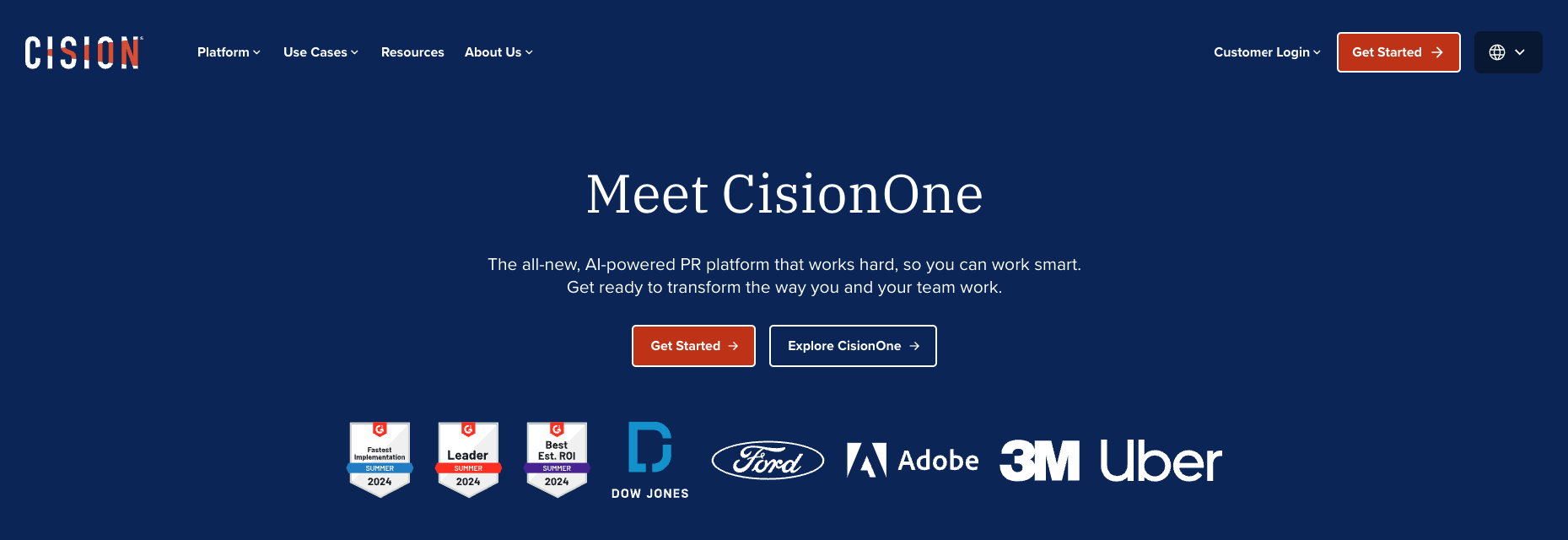
Cision (the database tool is technically called CisionOne) is cited the most when discussing media database tools due to its massive list of journalists and media outlets.
Because of the database size, we also featured this as one of our top digital PR tools.
Cision is involved in many different PR products these days. It owns PRNewswire, which you may have used for press releases. It also owns Connectively, formerly HARO (Help a Reporter Out), and bought Digital PR platform provider Trendkite in 2019.
The tool is part of a comprehensive platform that includes a media database, media listening tools, a press release creator, and an email outreach platform.
What Do the Experts Say?
Tonje Odegard, the Outreach Director of London-based digital PR agency Verve Search says,
“The journalists themselves describe their sector or coverage area rather than some clueless researcher trying to put them in a box.
This makes finding truly relevant contacts easier.
The ‘Recent Articles’ and Twitter feed overview in each journalist’s bio are great ways to check the frequency of their coverage and whether they actually write about relevant topics.
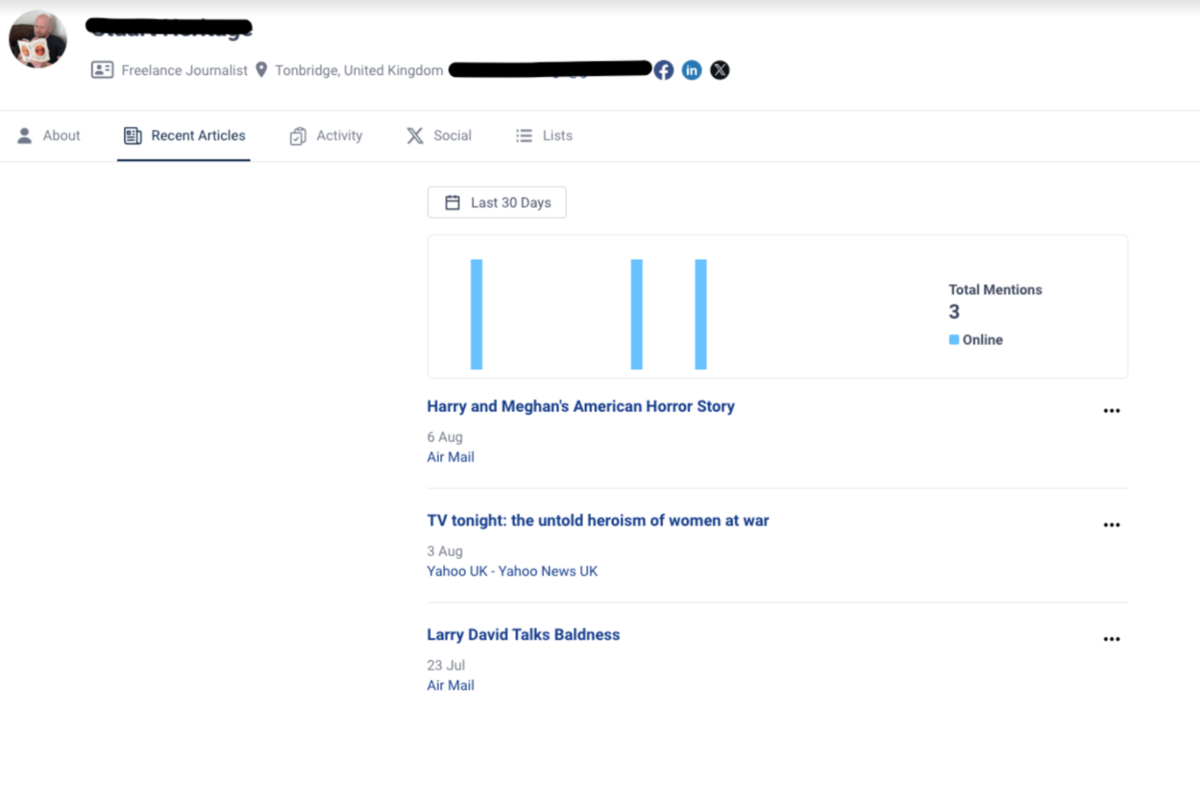
There are some UX niggles that are still causing some mild frustration, but these are minimal. Besides, the customer service team is very receptive to feedback and usually aims to improve on issues pretty quickly.”
Key Feature
Their main feature is their extensive database of over 850,000 media contacts, 190,000 journalists, and 1.18 billion social media profiles.
They also report updating the database more than 20,000 times a day. (This information is taken directly from their website.)
Here’s what it looks like in real-time:
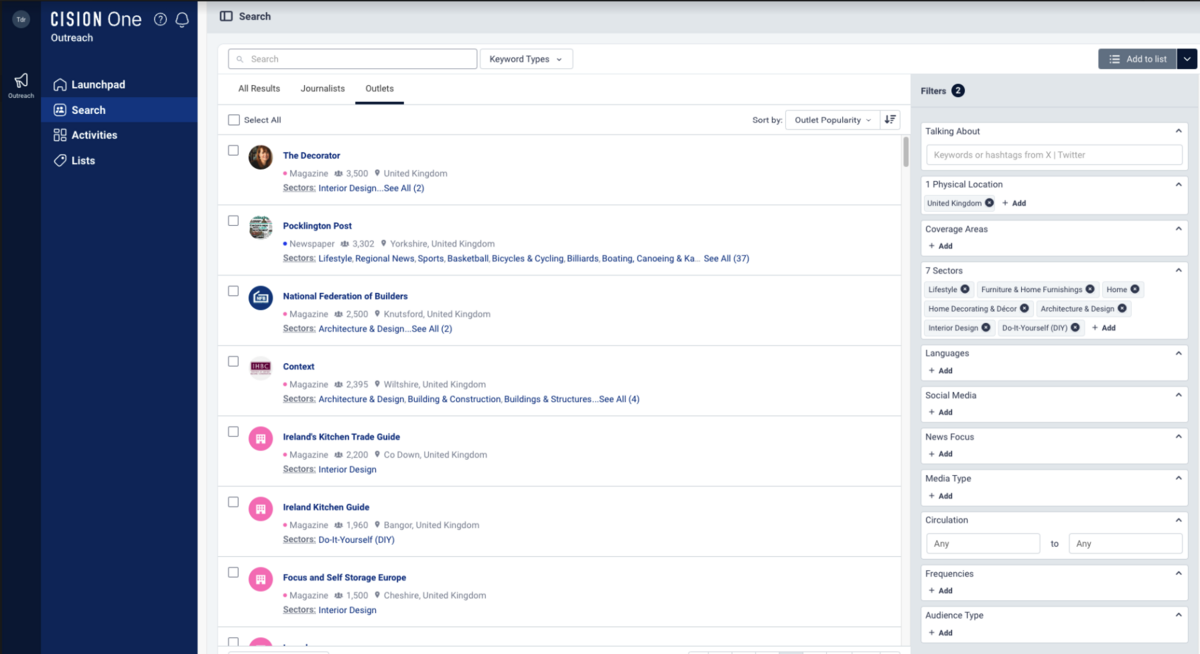
As you can see, it’s very comprehensive.
Pricing
Visit their site for more accurate pricing and a demo.
We estimate $6,000/yr based on user testimonials and reviews, but it varies widely based on the additional tools and number of seats.
One Reddit user offered this advice when dealing with Cision’s sales team (which is generally great advice when dealing with any sales team at a large company):

2. MuckRack – Most Accurate Database
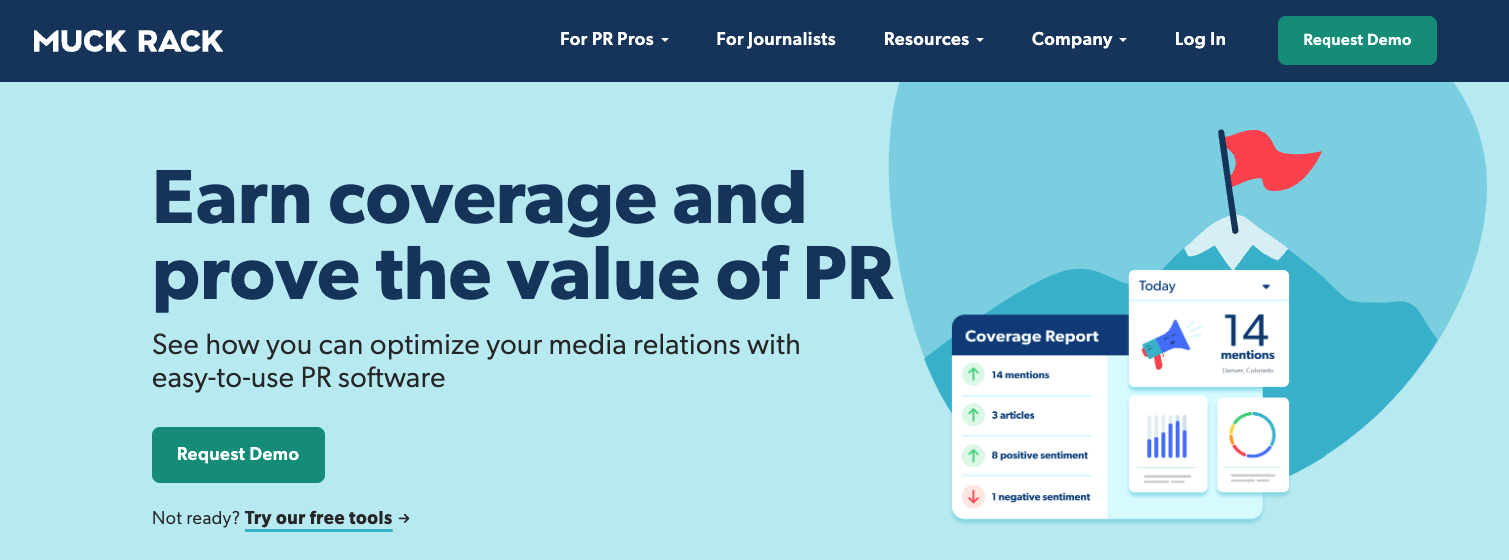
MuckRack is the most talked-about database tool as an alternative to Cision or Meltwater.
Like Cision, the software offers a media database, monitoring, pitching, and reporting capabilities.
MuckRack differs from Cision in the size of its media database. Its size is estimated to be around 300,000 contacts, though many seem to think the database is more accurate than Cision’s.
I’ve heard similar feedback from our customer, as echoed below on Reddit:
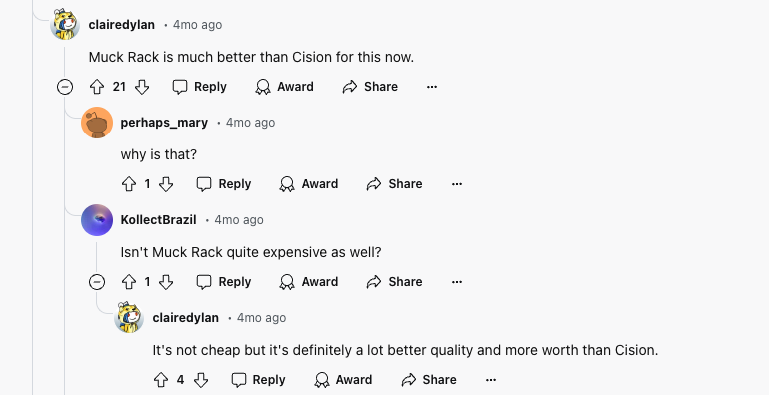
Their database search tool offers many filtering options, such as date range, keywords, beat, scope, location, etc.
Below is a screenshot of the free version of their tool:

You run into limitations in the number of search results.
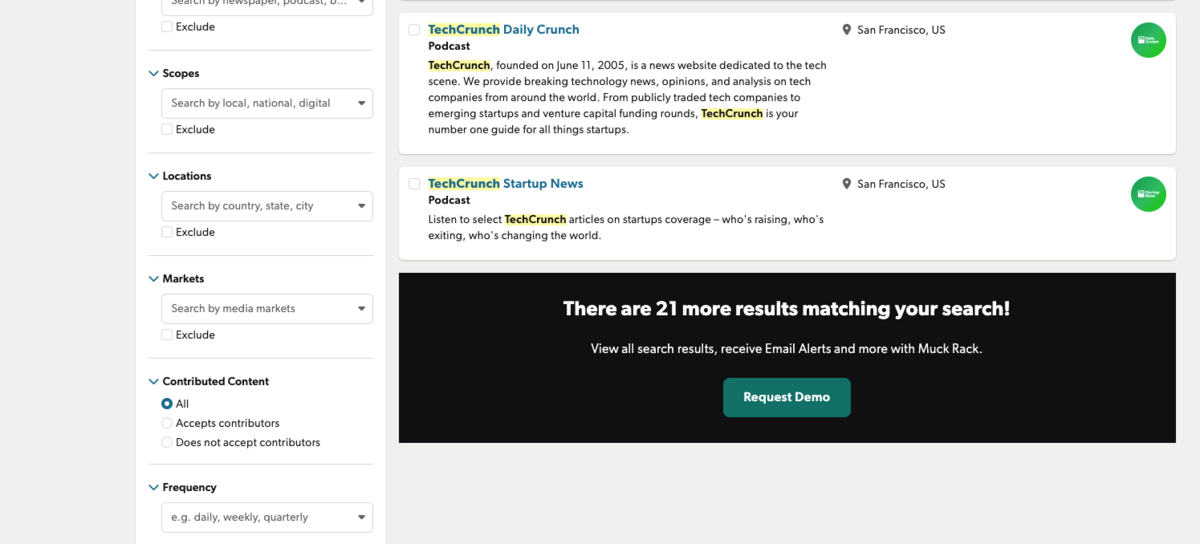
Obviously, they aren’t going to give away the kitchen sink for free, but if you are looking for small-scale outreach projects, the free version may be enough.
What Do the Experts Say?
Helena Maniglia, the Head of Digital PR at digital PR agency, Reboot Online, whom you can also see on one of our podcast episodes, told me that her team uses Muck Rack.
“After trying out a few media database tools and conducting extensive research to find the best one, Muck Rack stands out for having the most up-to-date and accurate information about journalists compared to others, including their most recent articles.”
I also spoke with Ben Treanor, Founder and Director of digital PR agency Break of Dawn, who echoed similar sentiment.
“We’ve used Muck Rack continuously since 2021. I love the depth of the database and vast number of journalists and media outlets curated in the platform.”
In terms of what to improve, Helena said:
“The search feature could be more user-friendly. The dropdown option sometimes makes it hard to visualize all you must select when searching.”
You can see that mention on Reddit where the search feature within the database is not as good as simply Googling “Journalist Name + Muck Rack.”
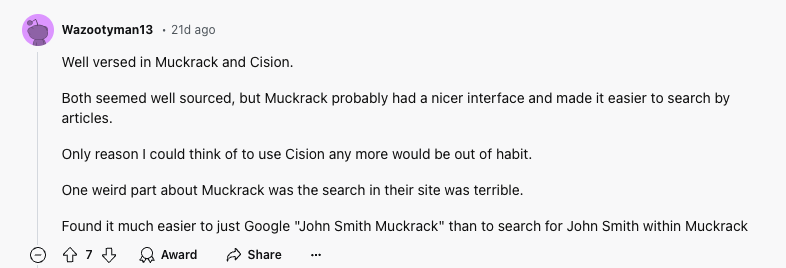
The last note on MuckRack is that it has outreach capabilities tied to its media database.
However, when I chatted with Collin Czarnecki, the Director of the digital PR agency NOBLE Digital Studio, I realized that they were somewhat lacking.
“Not only do we personalize our pitches in terms of the content, but we also tailor the timing of each pitch to the contact. One feature that BuzzStream offers, which MuckRack lacks, is the ability to customize the time a pitch is sent to contacts within a list.
For example, if we pitch a local TV news outlet in Chicago, we might want to reach early morning producers and evening producers at different times. BuzzStream allows us to do this without creating a new list.
However, with MuckRack, we need to segment those contacts into separate pitches or lists, which can be tedious when pitching multiple local news outlets.”
While this post is about media databases, not outreach tools, your list is only as good as your outreach strategy. Personalizing your email outreach based on a reporter’s time zone can mean the difference between coverage and no coverage.
Key Feature
MuckRack has a feature that allows journalists to update their contact preferences. This is a potential game-changer.
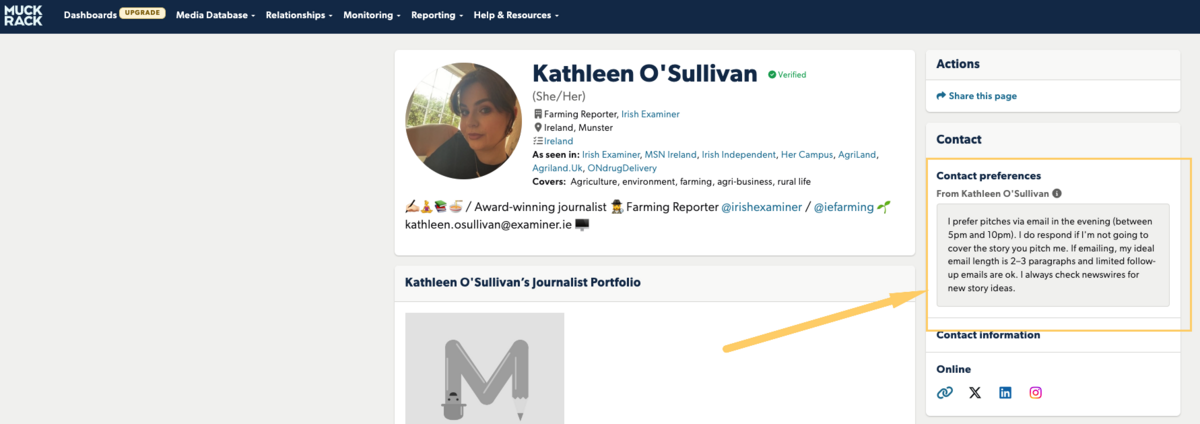
You won’t find this on every profile, but when you do, it’s like a cheat sheet for ensuring your coverage gets read.
Helena recommended the Trends feature, which, similar to Google Trends, compares articles published based on keywords over a specified period.
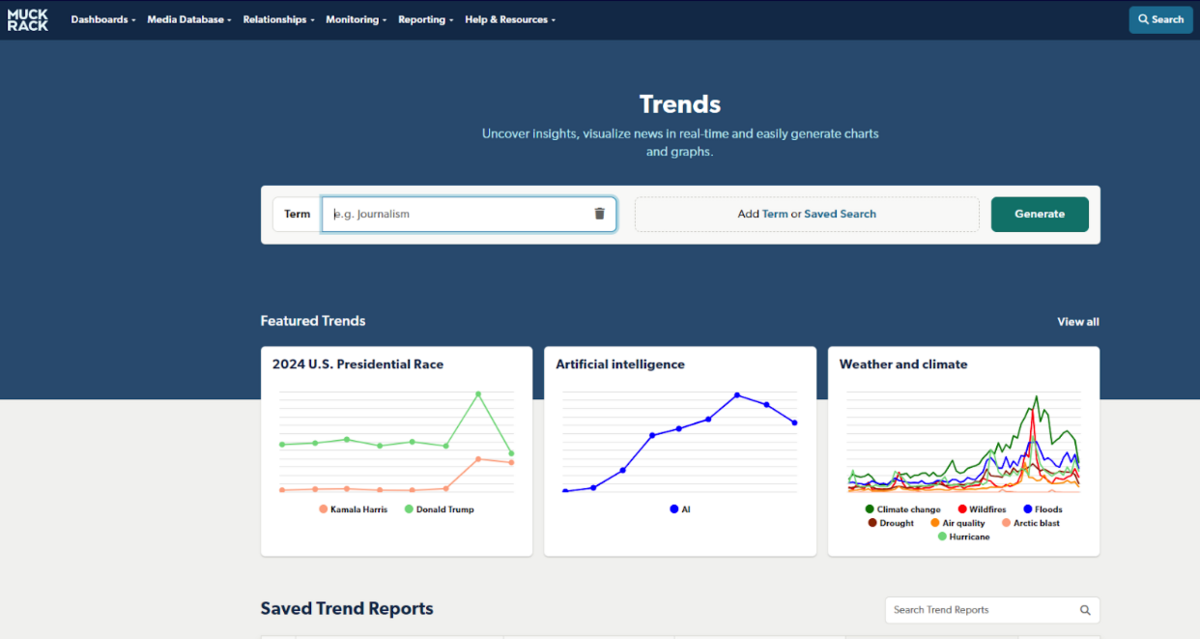
Helena says, “This allows you to analyze trending topics over time and plan campaigns around major events and dates.”
Ben informed me that Muck Rack recently added several AI-powered features to enhance its search function. You can see this in the “Recommended Journalists” section below.
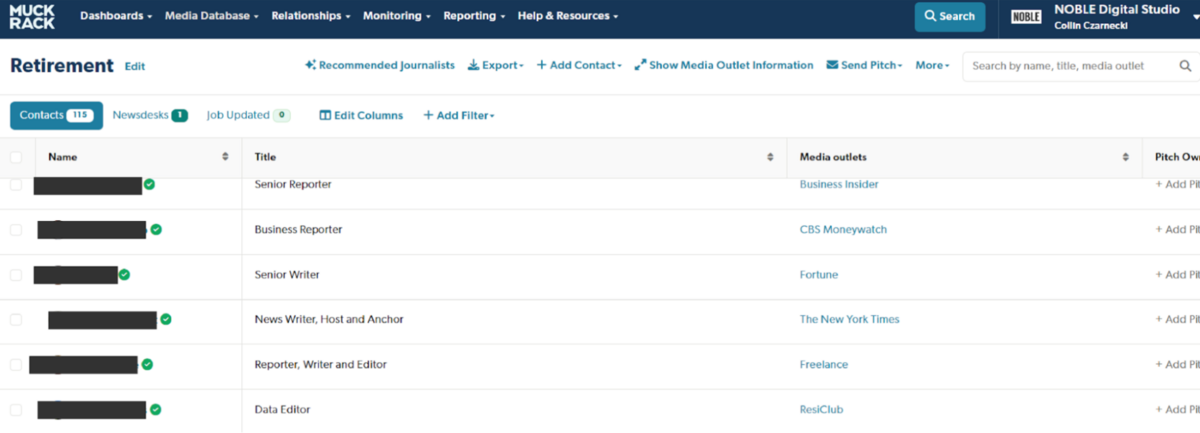
“While these are still in their relative infancy, the future of these integrations looks promising. But as an organization, our agency loves the Muck Rack Academy feature!” which you can see below:
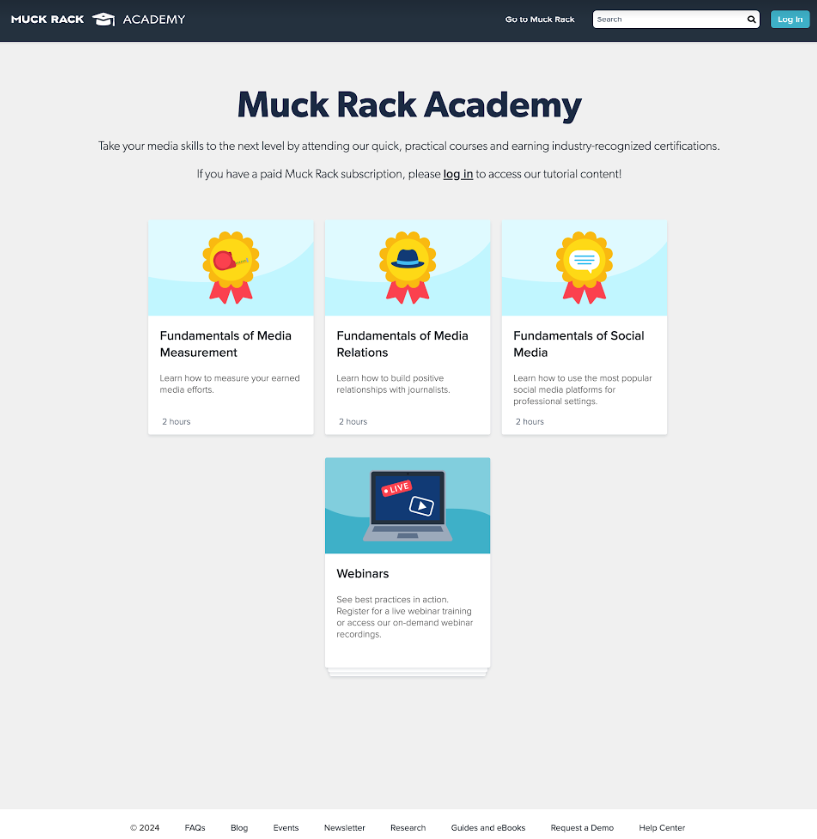
“It’s an invaluable resource for quickly onboarding new hires onto the platform.”
Pricing
MuckRack has a free, limited database tool I’ve used quite often, but you need to contact them for the full pricing.
Although one Reddit user offers this tip for smaller agencies using MuckRack:

I can’t say that this works, but it’s worth a try.
3. BuzzStream ListIQ – Media Database Alternative
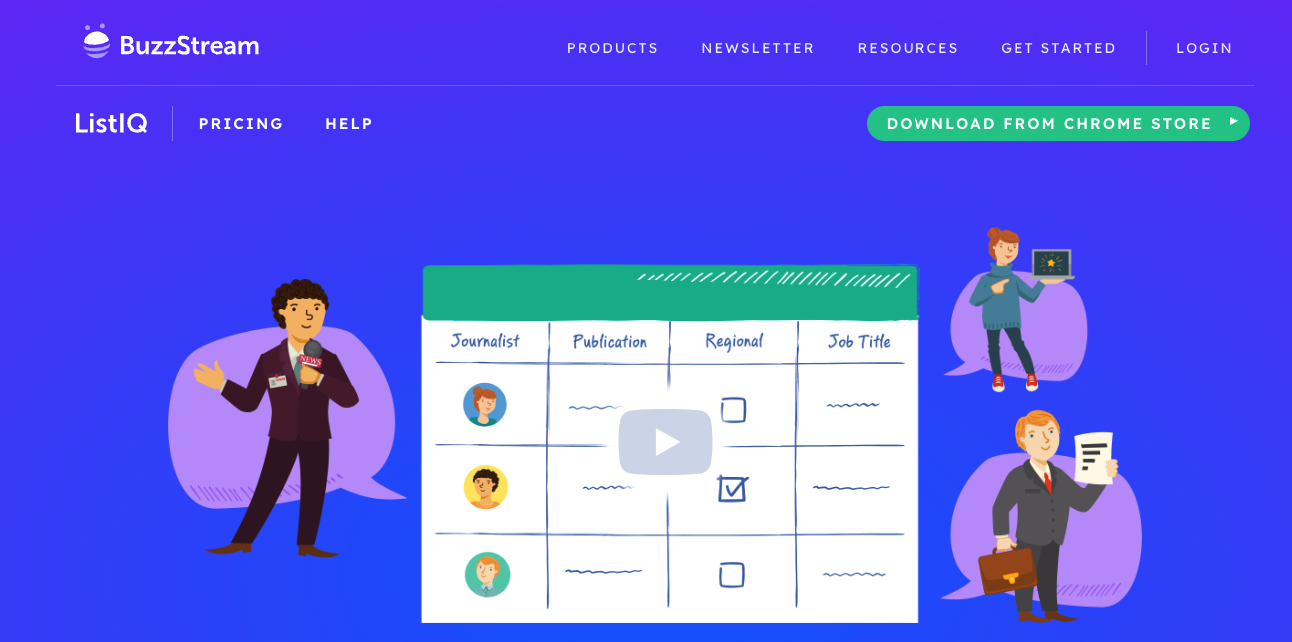
BuzzStream’s ListIQ is a tool for building media lists without requiring a database. Instead, it allows PR pros to create a list directly from a Google News search.
Building lists from databases often casts a wide net, which, as we’ve seen with our studies, drastically hurts open, response, and even link numbers:
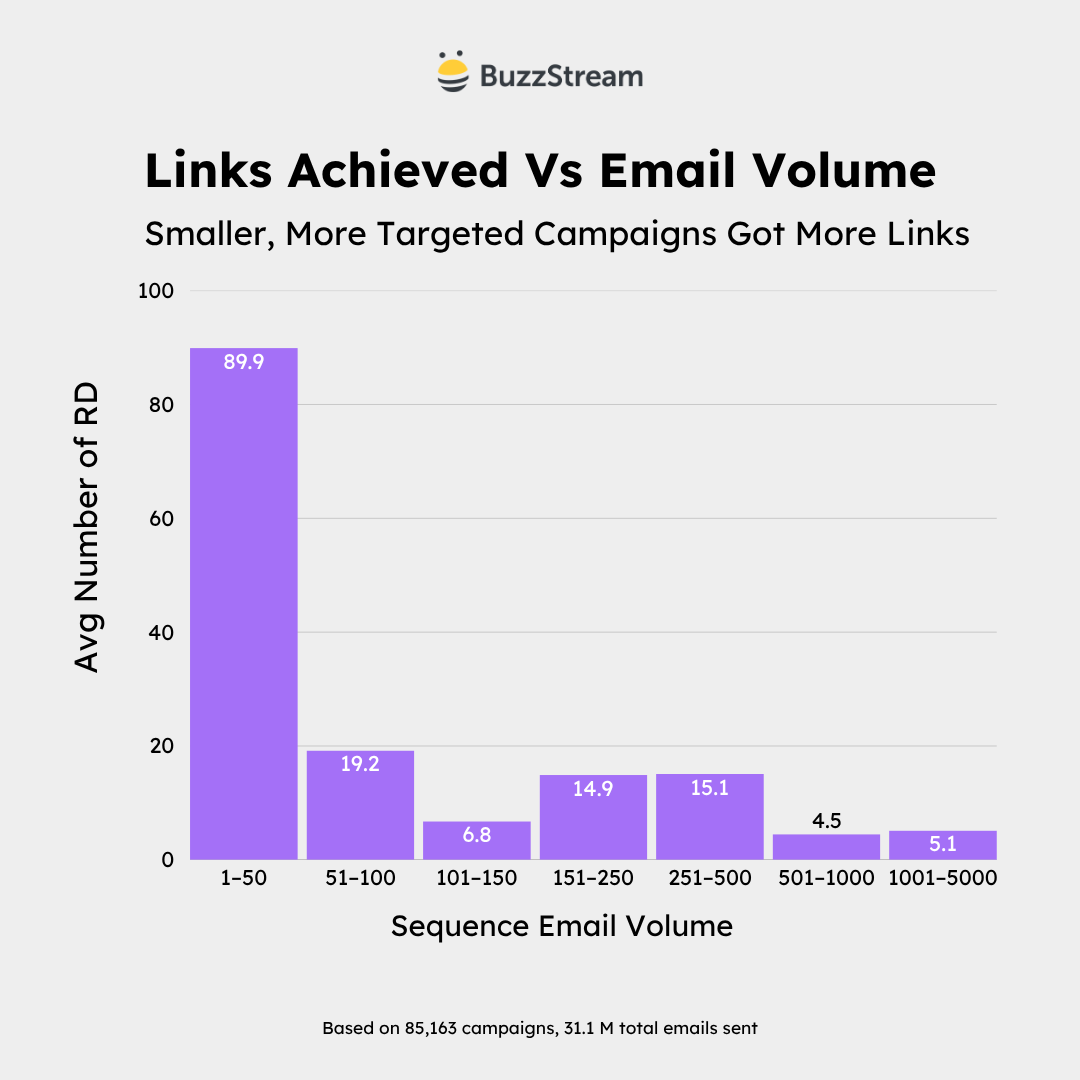
The solution is to build a media list yourself, but it’s an incredibly time-consuming endeavour.
What Do The Experts Say?
According to the experts, ListIQ is definitely the best solution for manually building lists.
Kalina MacKay, SVP of Owned Media at Go Fish Digital, told us, “ListIQ is a total game changer for outreach teams. We used to spend hours manually digging through Google News to find relevant journalists and contact information, all of which can be done now with the click of a few buttons.
The contacts are more targeted than those pulled from media databases, without the time-consuming research.”
This aligns with the other complaint we’ve heard about traditional media list building tools — as noted in our State of Digital PR report — that these tools are often outdated or incorrect.
Media databases tend to cast a wide net, which means PR pros often fail to reach relevant journalists.
As we saw in our PR trends study, journalists are facing an increasing number of irrelevant pitches every year, which is the primary reason they will block or ignore a pitch.
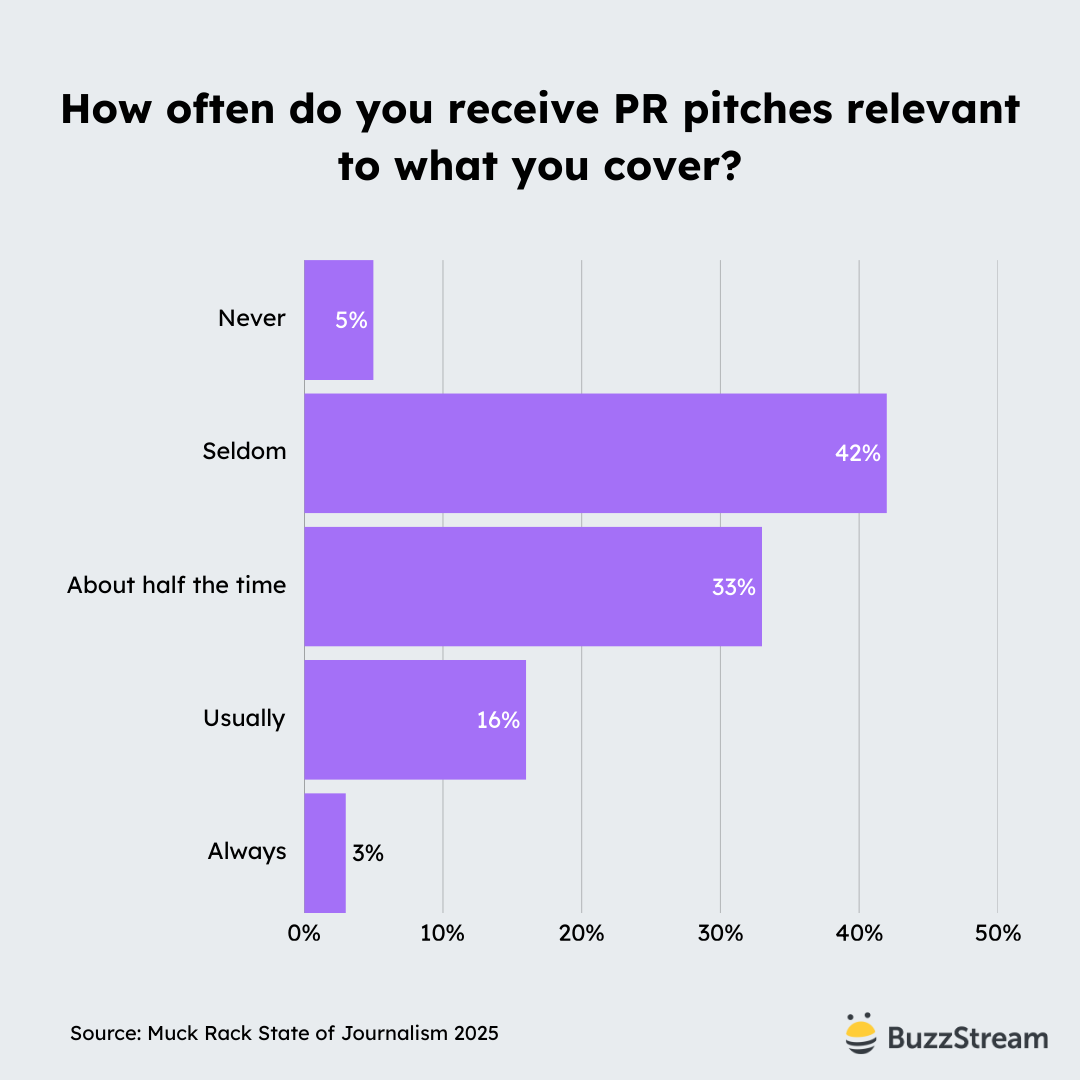
Key Feature
The key feature of ListIQ is being able to build media lists directly from Google News searches.
Normally, if I’m trying to build a list manually, I perform a Google News search and then need to dig into every result one by one.
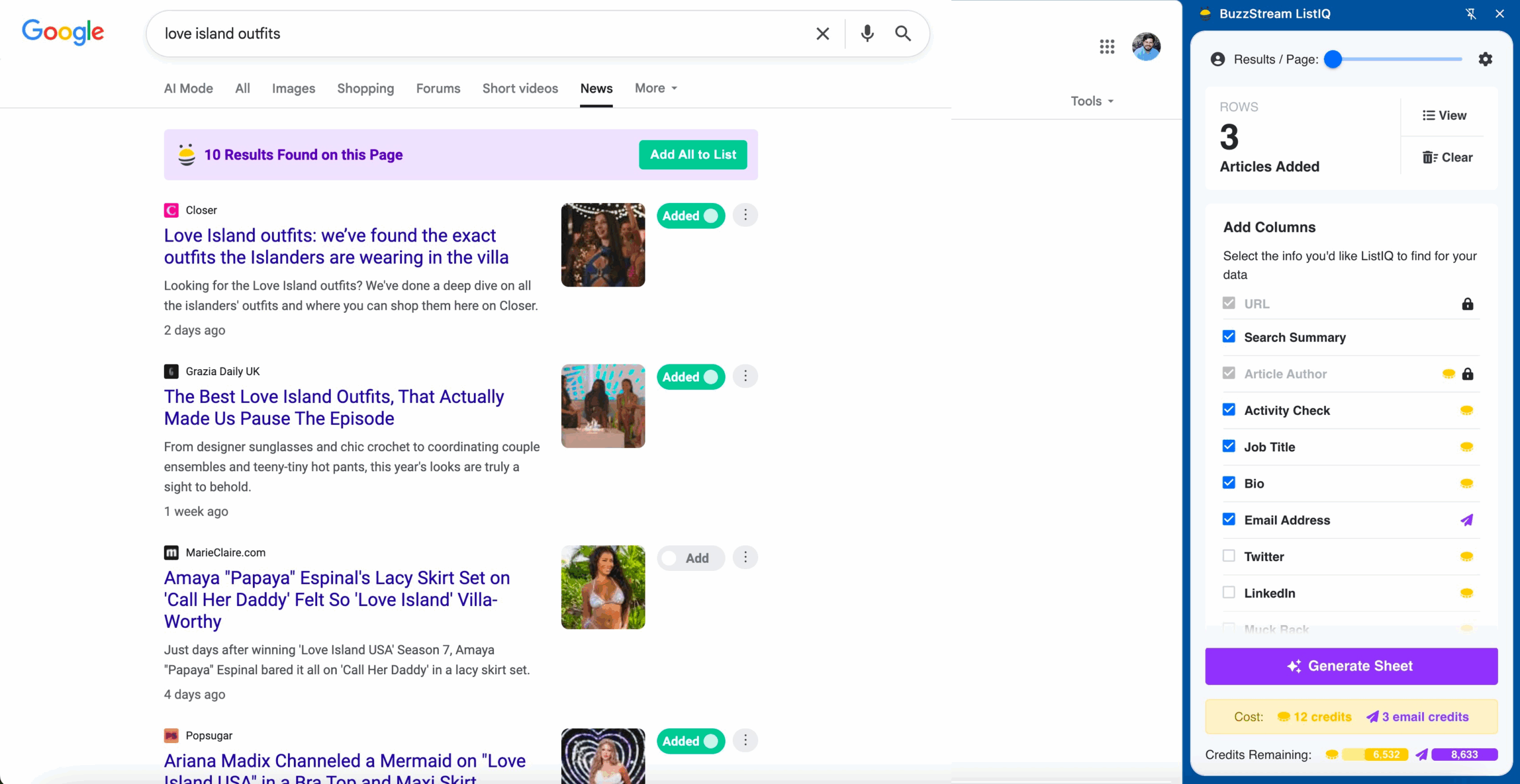
I’m checking who the journalist is, reading their bio, and reviewing recent articles, and then I’m digging around to try to find their email address.
With ListIQ, I select specific articles from the search results and choose the information I want to find about the journalists.
Then ListIQ goes out and builds a list for me in a few seconds.
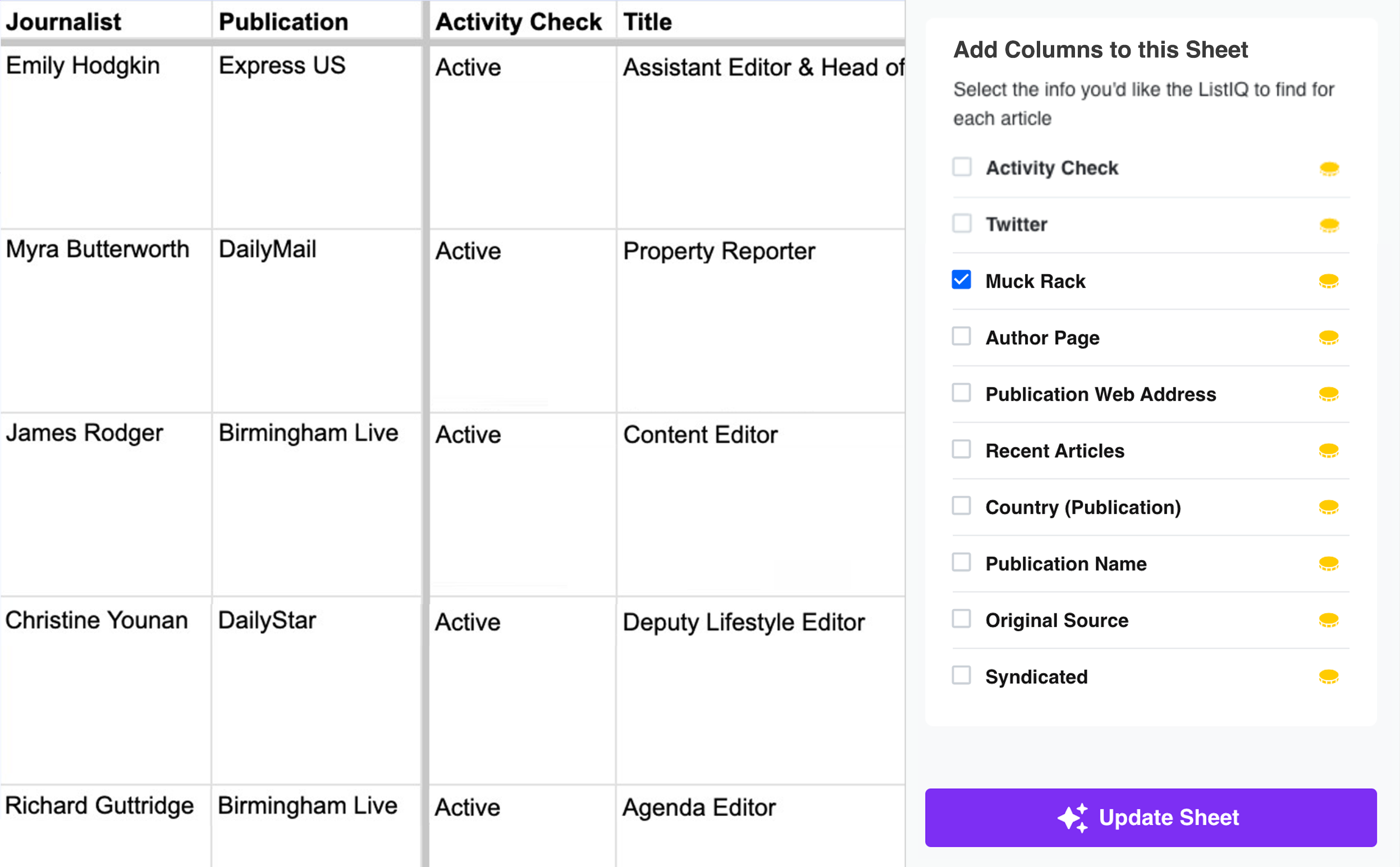
The ability to research these at scale drastically increases the number of relevant journalists I can find. It does it in a fraction of the time it takes me to research a single journalist, usually.
Pricing
ListIQ offers a free tier that provides 200 Standard Credits and 20 Email Credits. The first paid tier is $99/mo for 1,000 Standard Credits and 100 Email Credits. There is also a growth and pro tier. See the pricing page for all details.
If you’re looking for a database in the UK, read on.
4. Roxhill – UK Standard

Roxhill is a media database for UK and international journalists, broadcasters, bloggers, and podcasters.
I’ve always heard Roxhill as the de facto choice for PRs in the UK, and my interviews with customers have solidified this.
As you can see, the sentiment online is pretty similar as well.
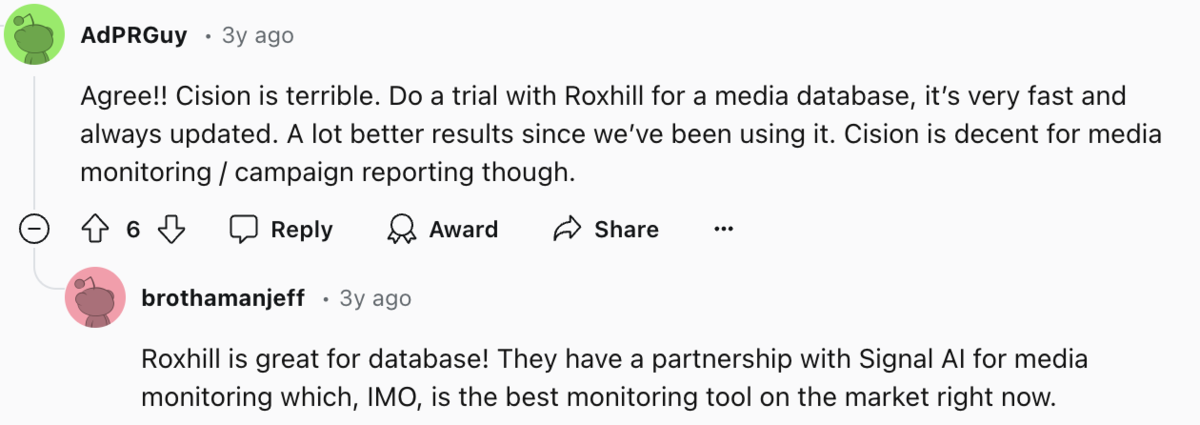
Roxhill also has media alerts (featured on our HARO alternatives) and even journalist requests, which are similar to the next tool on this list.
What Do the Experts Say?
I spoke with Amanda Walls, Head of SEO & Digital PR at UK-based Digital PR agency Cedarwood Digital, and she seemed to think that Roxhill appears to be the most comprehensive — especially for UK journalists.
Here’s a look at it in action:
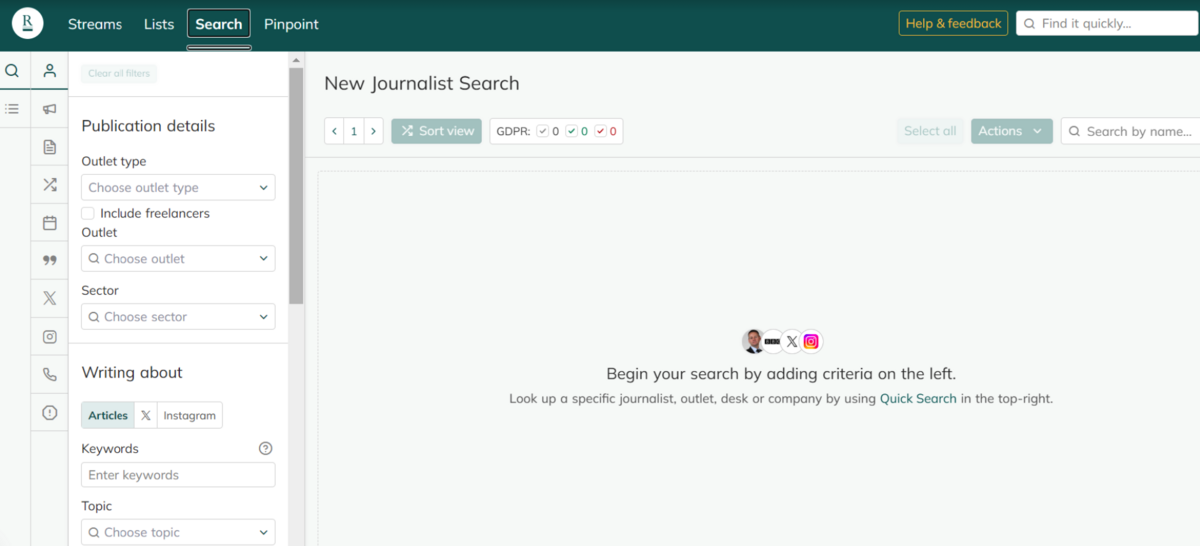
“The filtered search function allows the team to filter contacts based on specific criteria such as industry, publication, location, job title, etc. This enables highly targeted outreach, which has resulted in thousands of pieces of coverage over the years.”
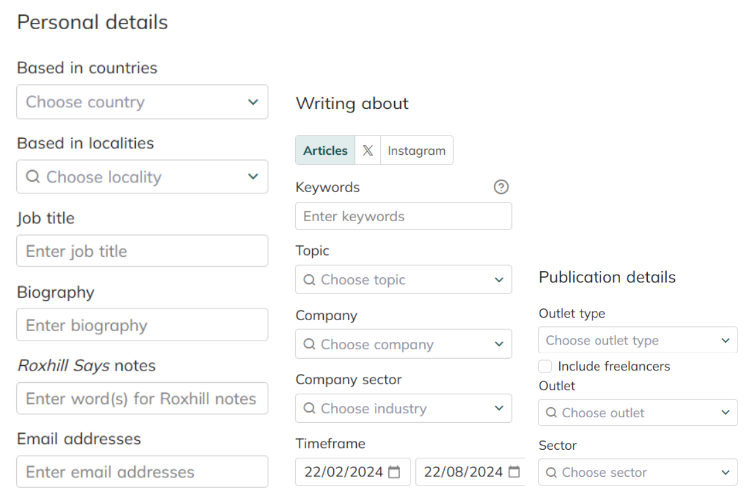
I also spoke with Abi Bennetts, the Digital PR Director of UK-based digital marketing agency Propellernet, about Roxhill; she also mentioned the search function.
“Their search function, in general, has a huge range of filters you can apply to find the perfect journalist for the story you’re pitching – you can get granular, which is great!”
Another pro of the platform that Abi called out is that Roxhill has been great at updating journalist moves, which “ is no mean feat when there are so many journalists to keep up with!”
Also in terms of improvements, “their UK database is great, and US contacts are normally pretty easy to find too; however, generally, their international contacts (for example, across Europe) could be built out a bit more.”
Key Feature
Since I haven’t used Roxhill myself, I deferred to Amanda here. She mentioned that her team loves Roxhill’s ‘Pinpoint’ feature. After digging into the feature some more, I realized that another one of our experts, Amy Irvine, Digital PR Director from UK-based agency, Digitaloft, also mentioned Pinpoint as a key feature.
Amy says, “The tool allows users to view coverage over time for topics, keywords, or companies and better understand what’s shaping today’s conversations.”
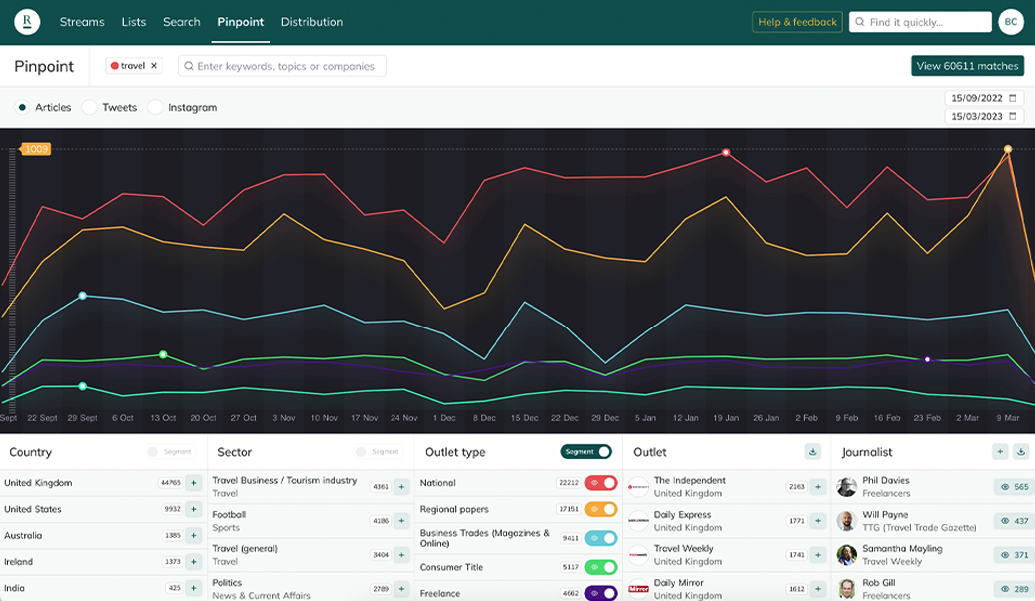
This seems like a game changer for those looking to do some newsjacking or reactive PR.
Pricing
Contact Roxhill for complete pricing, but according to Gov.uk’s Digital Marketplace, Roxhill costs
£3,000 to £25,000 an instance a year with a free trial available.
5. ResponseSource – UK Alternative

I hadn’t heard of ResponseSource before, but the UK-based digital marketing agency Distinctly suggested it as their tool of choice.
However, it makes sense because ResponseSource and Vuelio are now part of the Access Intelligence Group, so they share the Vuelio media database to provide over one million sources.
They are best for finding journalists in the UK but have extended their reach internationally with the addition of Vuelio.
The interface is very similar to the other media databases mentioned above, with the filters on the left and contacts on the right.
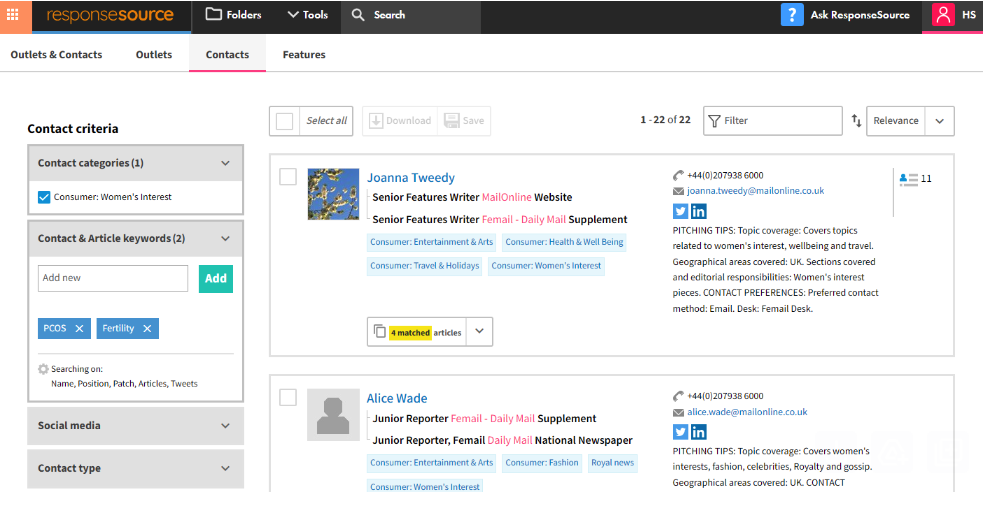
I like the little “PITCHING TIPS” they provide as a summary for the contact, which can speed up the process.
What Do the Experts Say?
Holly Scott, Digital PR Manager at Distinctly, says, “The interface is clean and straightforward, making it a simple platform for training new starters who join our team.
It’s regularly updated with journalist moves, including those who have left the industry entirely or have become unreachable for short periods.
What also swings this platform for me is its ability to search for keywords.
For example, if I search for ‘money-saving,’ ‘side hustle,’ and ‘return to the office’, in the publication and journalist search box, which then matches you with the journalists and news outlets that have frequently written articles on those topics.”
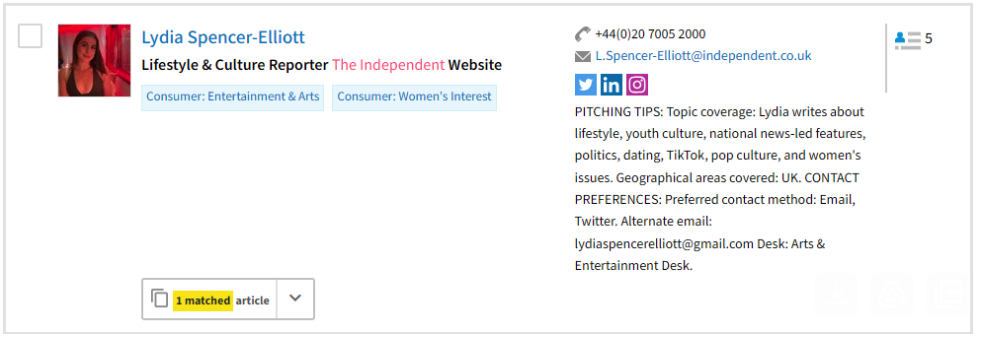
The matched articles dropdown lets you preview past articles to ensure the journalist you want to target writes stories that align with your client’s pitch.”
Holly mentioned some improvements, including increasing the “variety of journalists available on the platform.” She said she sometimes has to couple media list building on ResponseSource with Roxhill.
So, depending on how you look at it, that’s another point for Roxhill. However, the critical feature explained next is a game changer.
Key Feature
The critical difference with ResponseSource is that they also have a built-in journalist request feature.
For example, by selecting categories such as Business & Finance, Manufacturing, Engineering & Energy, and Health, you will receive real-time inquiries from journalists directly into your inbox.
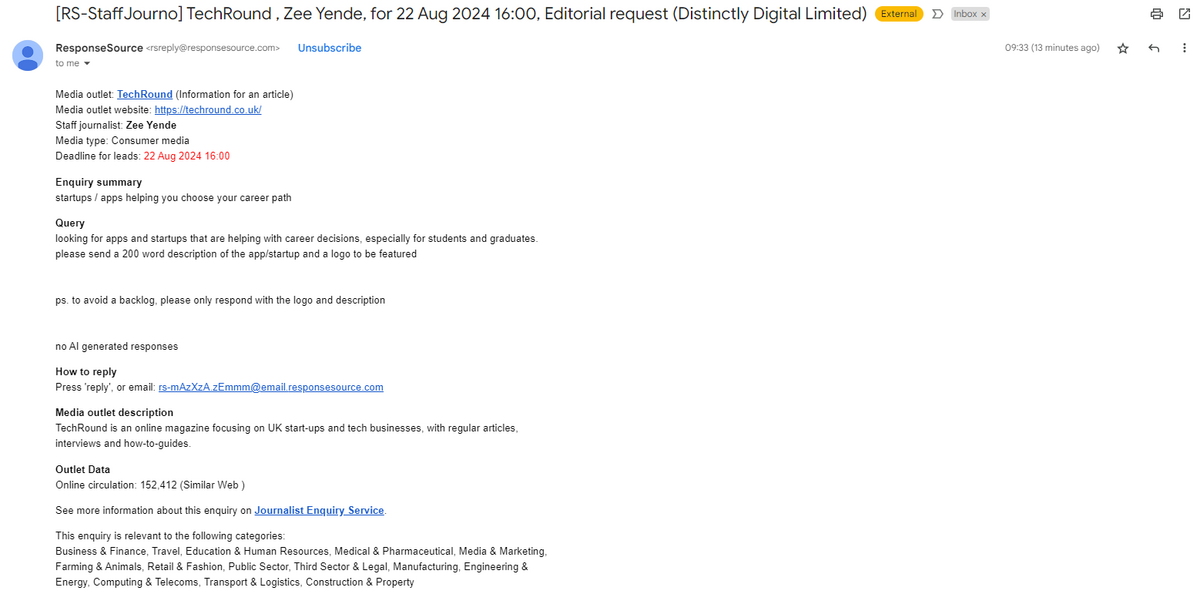
From Holly:
“This enables us to position our clients in front of the journalists, with their expert comments, survey findings, or opinions swiftly ahead of competitors. We enjoy doing it in our team, and ties in well with our reactive service offering.”
Pricing
Based on some feedback, with over ten seats, it’s estimated around £400 a month. Though we recommend contacting ResponseSource for accurate pricing.
6. Telum Media – ANZ and SEA Standard

Telum Media is a Singapore-based media database platform that supports Southeast Asia, East Asia, Australia, and New Zealand.
Most people I talk to that use it compare it to the Cision of Southeast Asia and Australia.

I had never used the tool but got a hands-on demo with their head of marketing. The interface is one of the best I’ve seen on this list.
The dashboard view below features both a quick search feature and the power search feature (more on that next).
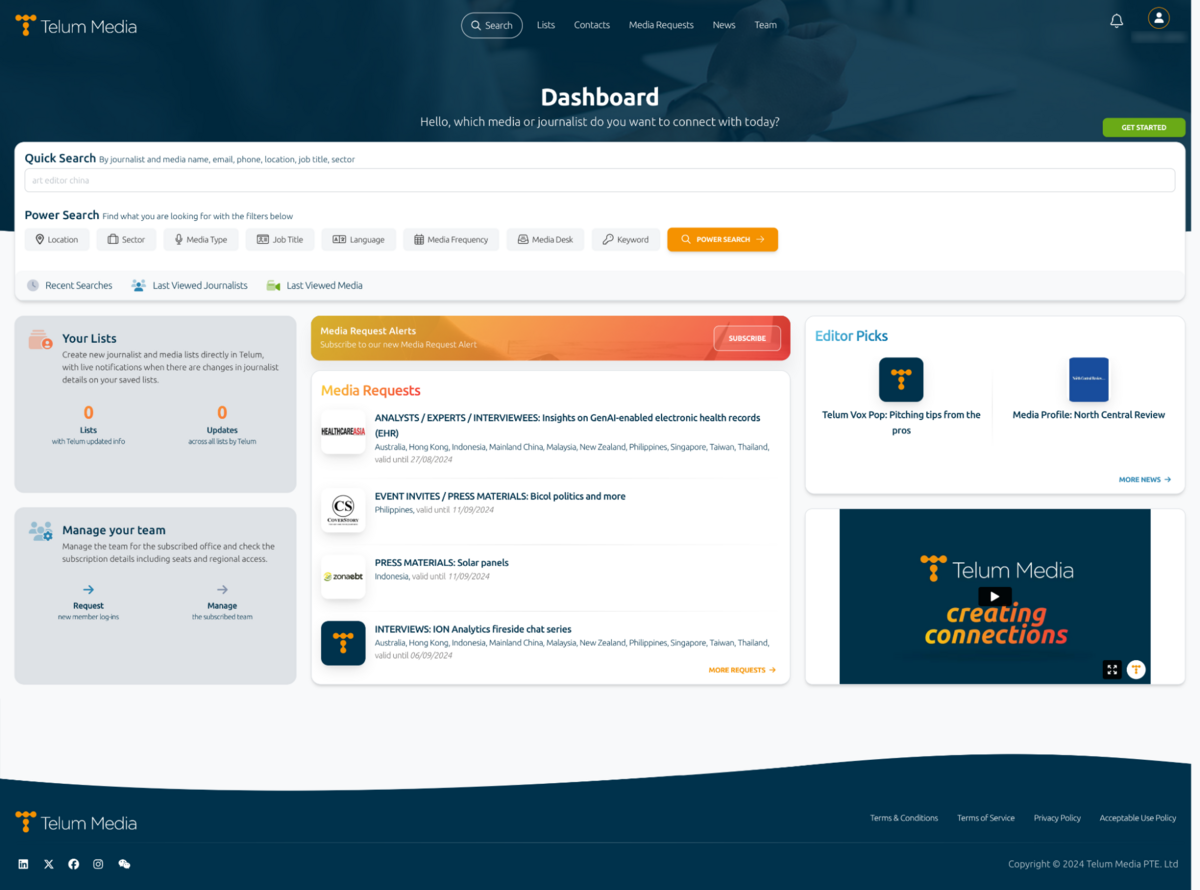
They provide a lot of information on the search and journalist profile pages but still manage to present it in a way that is not overly busy.
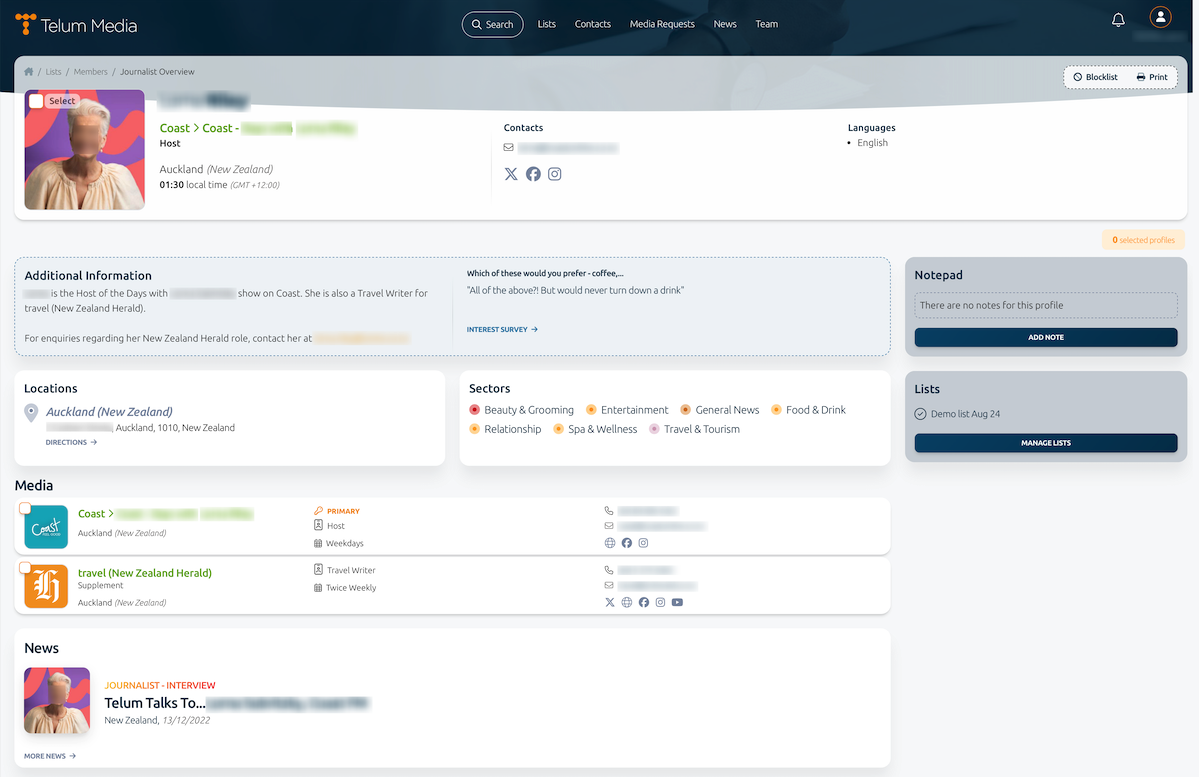
Their database is kept up-to-date through a continuous manual review process, and they constantly provide updates on journalistic moves on the platform.
It will even alert you about current journalists’ moves on existing lists you’ve created in the past.
What Do the Experts Say?
I spoke with Ellie Sumner of Prosperity Media, an Australian-based SEO, Content, and digital PR agency. She says her database of choice in Australia is Telum.
“I like using Telum as it seems to have the majority of Australian journalists’ contact details available, including phone numbers (which is a common method of pitching to journalists in Australia), making it really easy to outreach to target contacts.
Telum also provides a journalist Q&A, which the journalists answer and which shows useful information such as the best time to contact them, what they are interested in, the best way to reach them, etc.

Key Features
Based on my tour and Ellie’s feedback, we agree that one of the best features is that they showcase related journalists to the ones you have searched for:
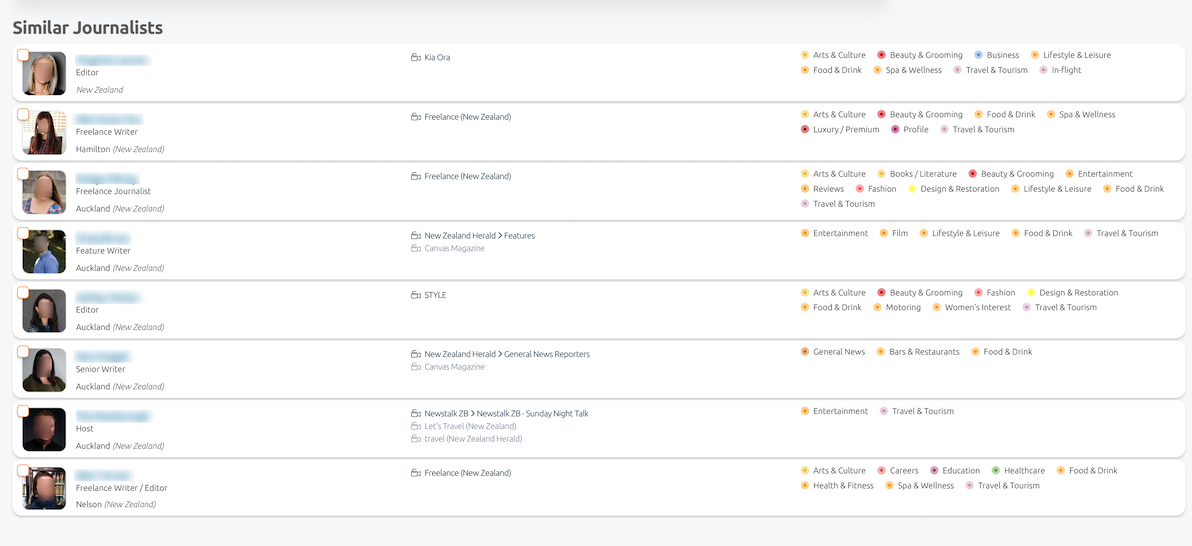
Ellie says, “The platform also has an excellent search function that allows you to find new journalists in the niche you’re aiming to target, which is especially good for news sites that don’t state the author of their stories.”
I’d expect more media databases to feature this, and I think it makes Telum stand out.
I found their Power Search feature to be very slick as well:
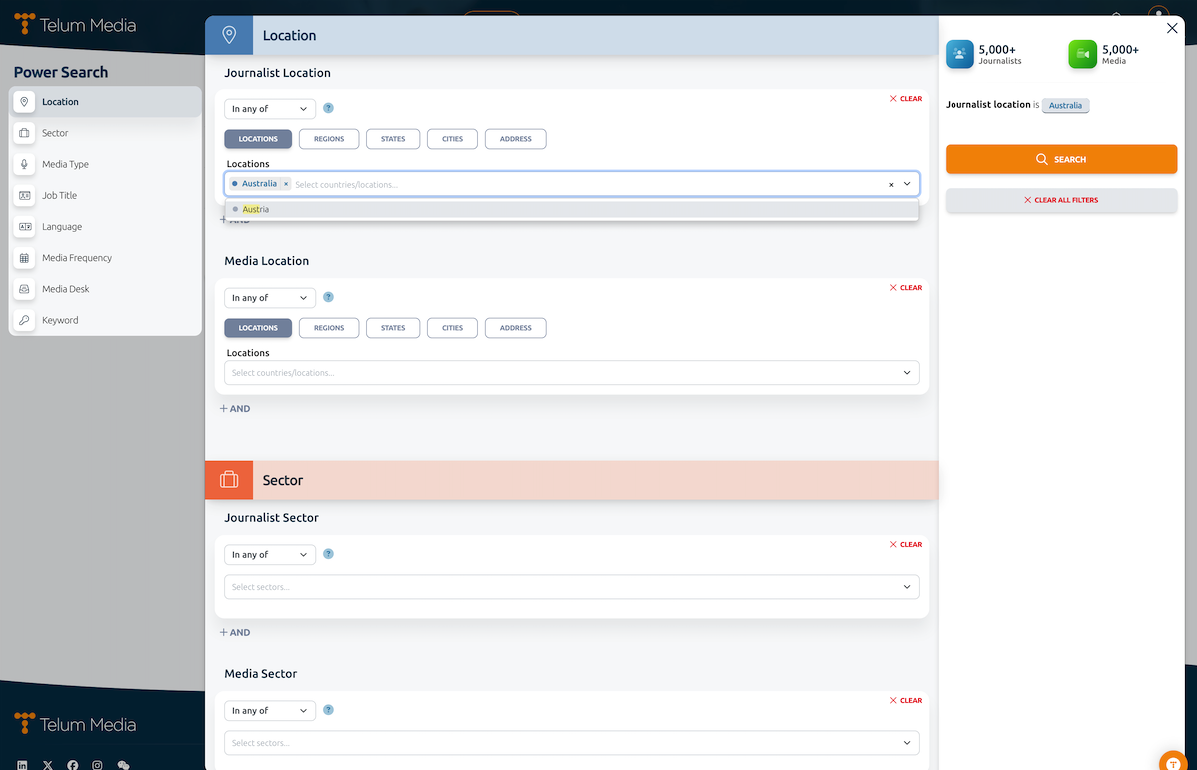
And while every tool has a search feature, this felt the smoothest and most comprehensive from a UX standpoint.
Pricing
You can contact Tellum for accurate pricing.
7. Prowly – Monthly Subscription

Prowly is a cheaper alternative to many significant media databases because it offers a monthly subscription. Prowly is part of the SEO tool, SEMRush, which is very popular in the industry.
Their interface is very straightforward with the filters on the left and results on the right.
You’ll also see the relevant articles they’ve written on the left when searching for keywords.
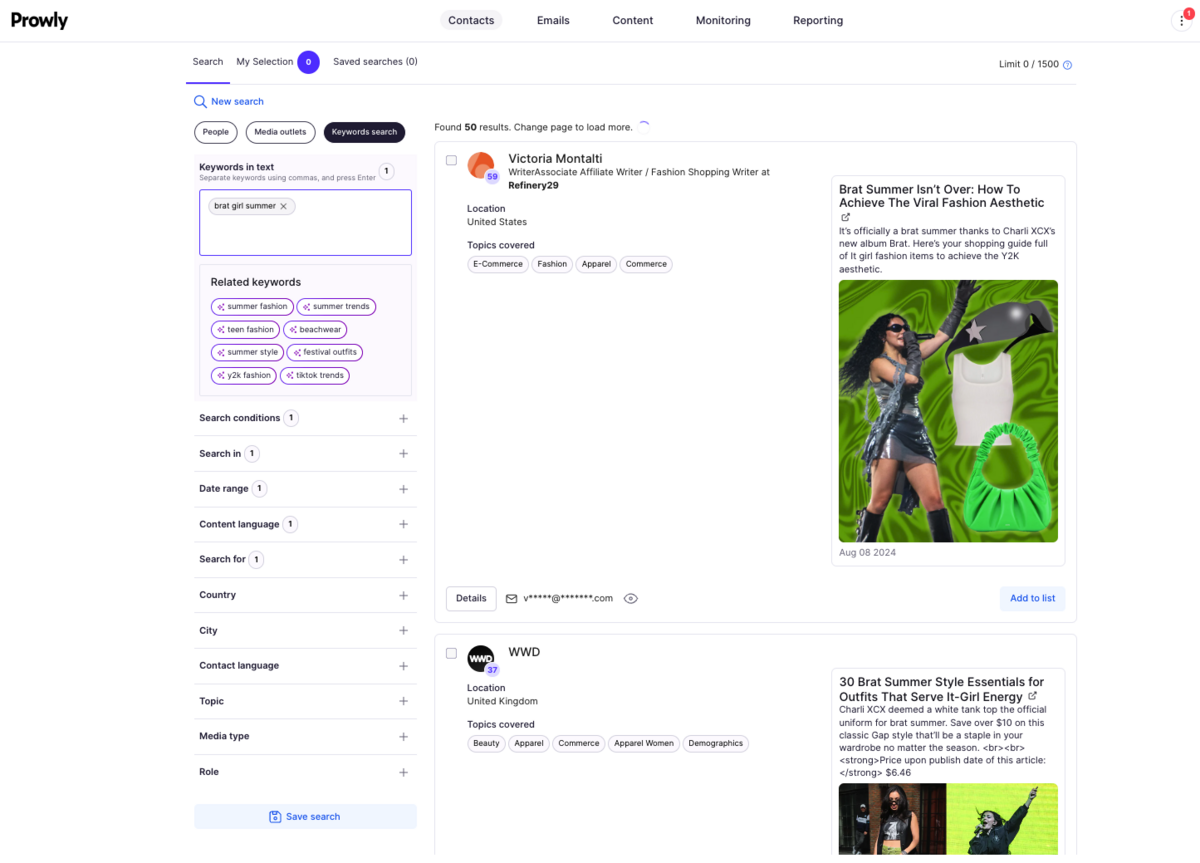
Then you can click on the journalist to learn more about them.
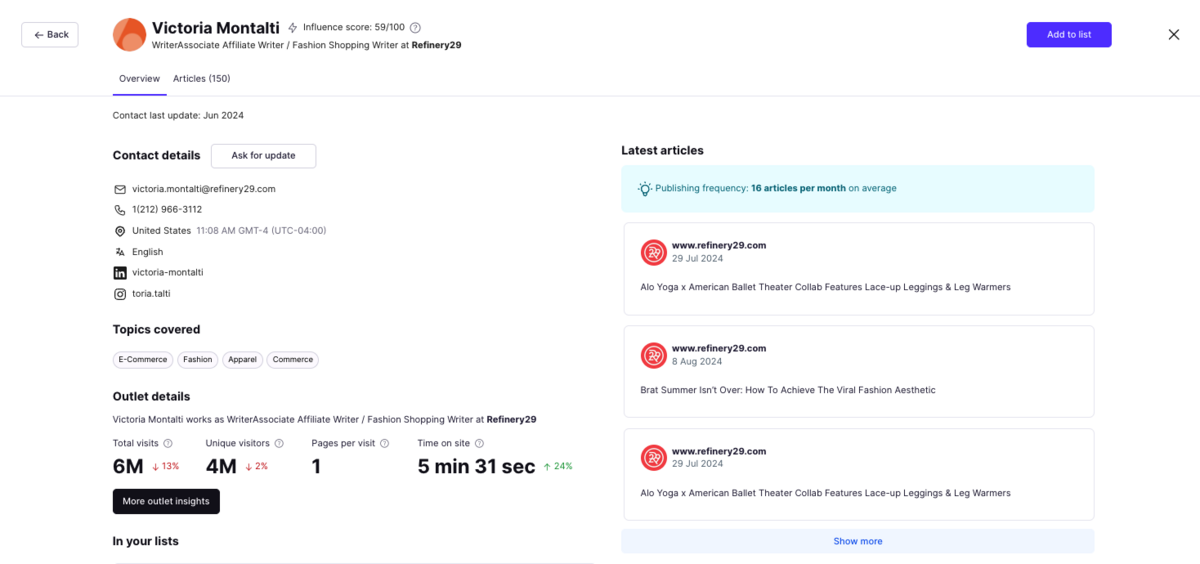
But let’s get into some actual use cases.
What Do the Experts Say?
I spoke with Amit Raj, the founder of The Links Guy, who uses Prowly for his digital PR campaigns.
“One of the main advantages of Prowly and for exploring it was the cost-effective/flexible plan that they had in place. Most PR platforms tie you into an annual contract, and you have to pay in the region of $6,000 to $7,000+.”
Prowly offers that comparison on their website:
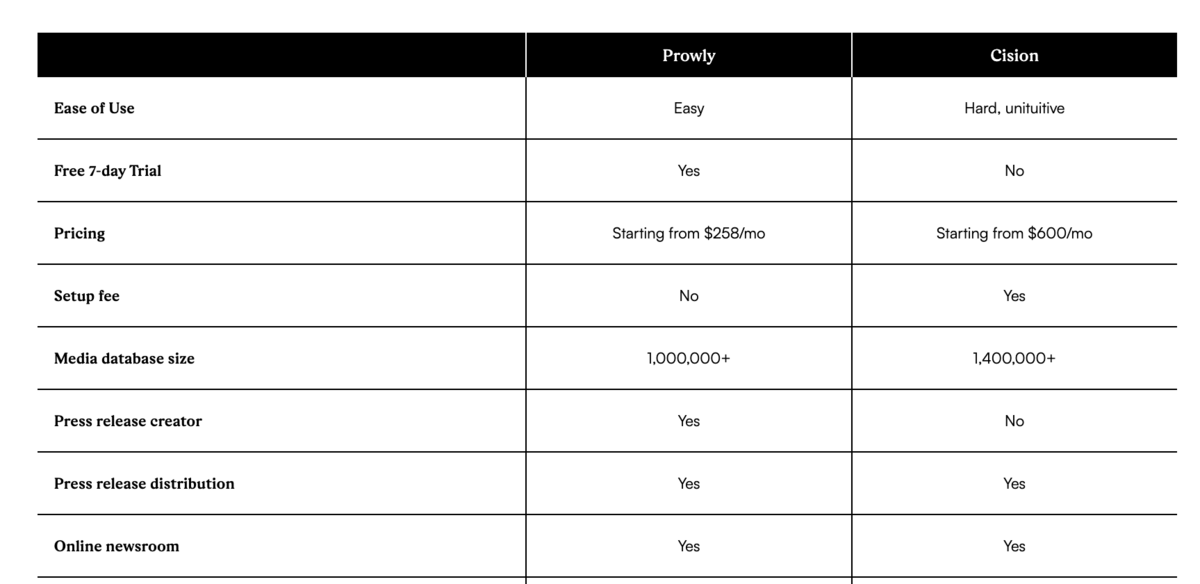
If digital PR isn’t your main service or not something you’re really looking to do regularly, then it can be hard to justify this. The only option I could find which was monthly was Prowly.”
In terms of what can be improved upon, Amit mentioned, “It is pretty well known in industry circles that Prowly is not the most comprehensive database for journalists. I had been reading some of the more recent talk on FB groups, but I was reading mixed reports—some said it was sufficient, and others said it wasn’t comprehensive.
When we checked—yes, it definitely isn’t as comprehensive, as I checked with a contact via a client who works in digital PR—and when we compared, CISION was able to give us much larger lists.”
In this case, you get what you pay for. It may be cheaper, but the database may not be as comprehensive as you’d like.
I did find that adding users to media lists is a little cumbersome because you can only add 50 at a time (even when you have more than 50 results).
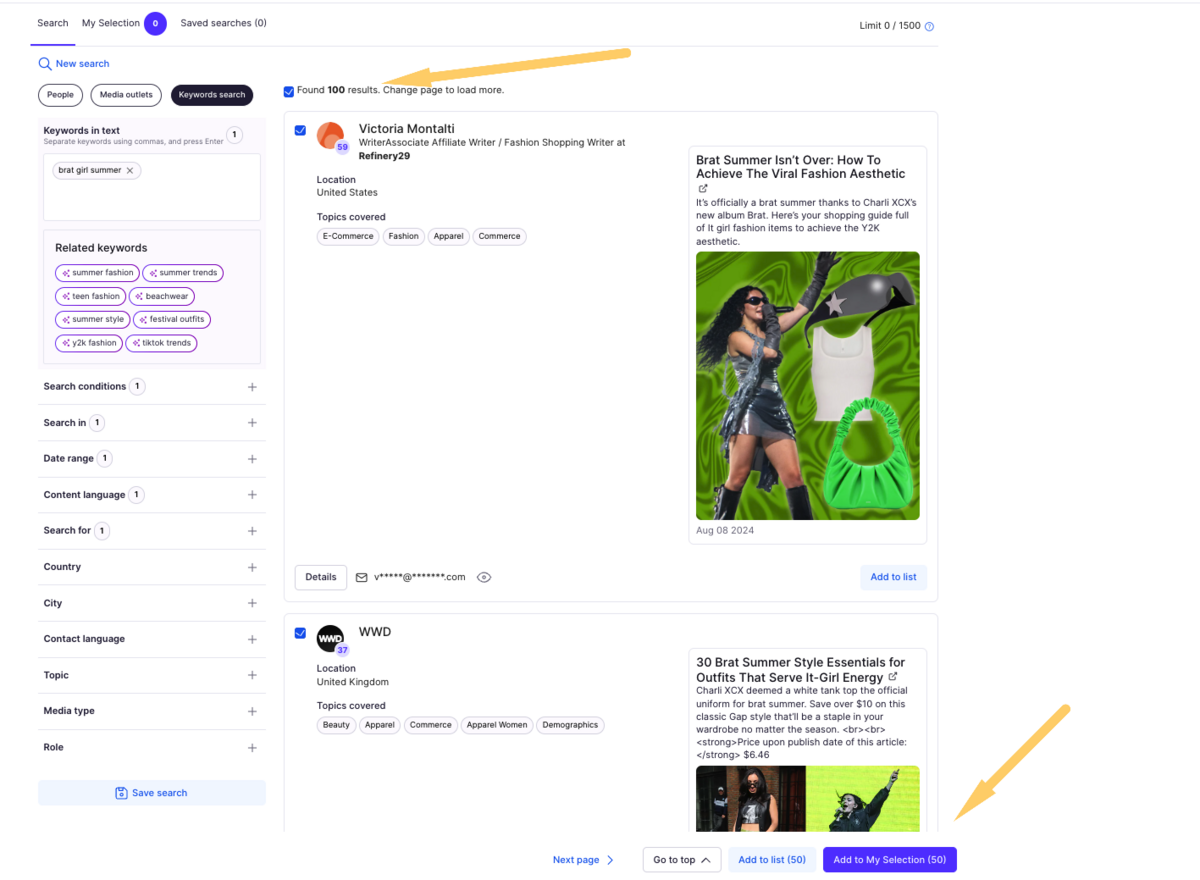
Though, vetting lists is always necessary, maybe this is a good excuse to slow down.
Key Feature
I like Prowly’s AI-powered keyword suggestions as part of their Keyword search.
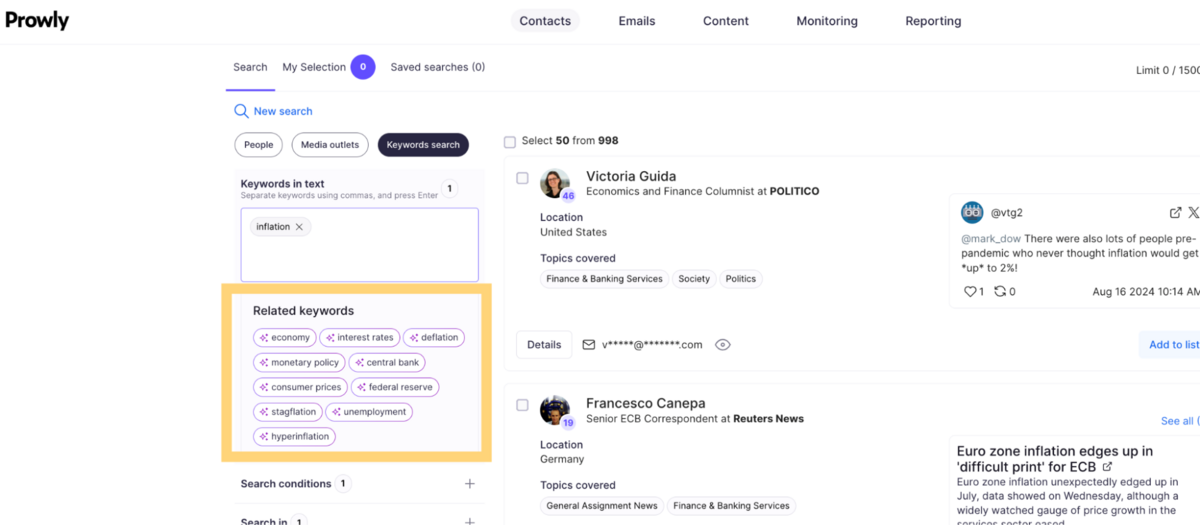
This can speed up the process and serve as a second set of ideas if you need some extra inspiration or are feeling a bit braindead mid-prospecting (come on, we’ve all been there).
Pricing
Prowly is one of the few database tools that is transparent about its pricing. Its pricing page states $258/mo for the lowest plan, which has some contact list caps.
8. BuzzSumo – Alternative Monthly
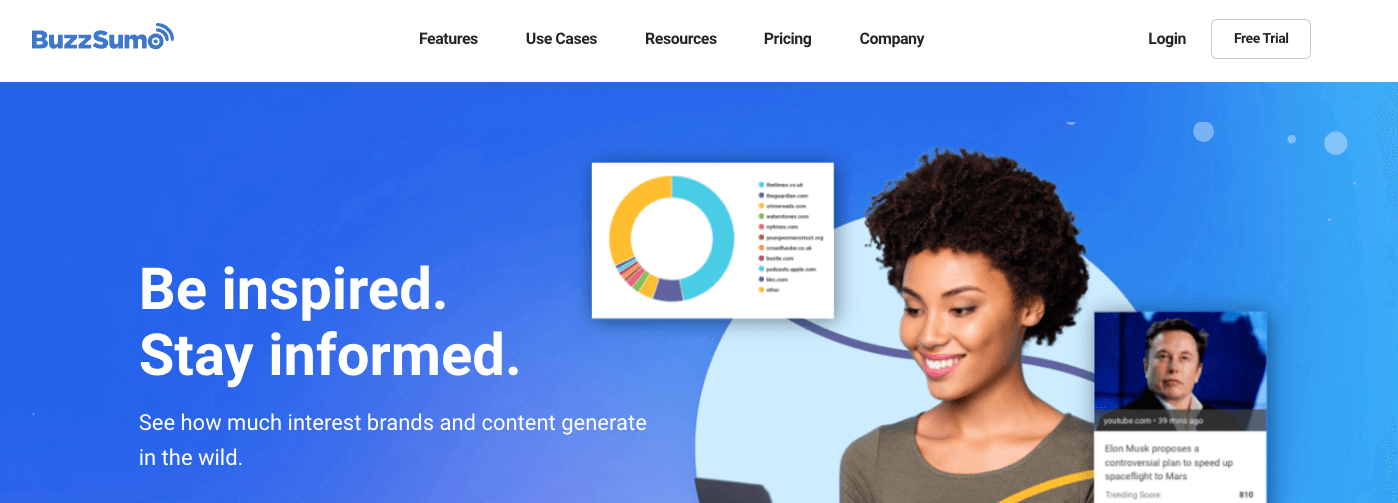
Fun fact: BuzzSumo is the company we (BuzzStream) most frequently get mistaken for. Starting as more of an influencer marketing tool, BuzzSumo now has a full-fledged media database.
We even mention them as a great option for social monitoring in our digital PR tools post.
Their relatively new media database already features over 700,000 journalists as per their website.
On the surface, the tool is relatively similar to other databases. But the profiles feature some really nice features, like article engagement and publication tier.
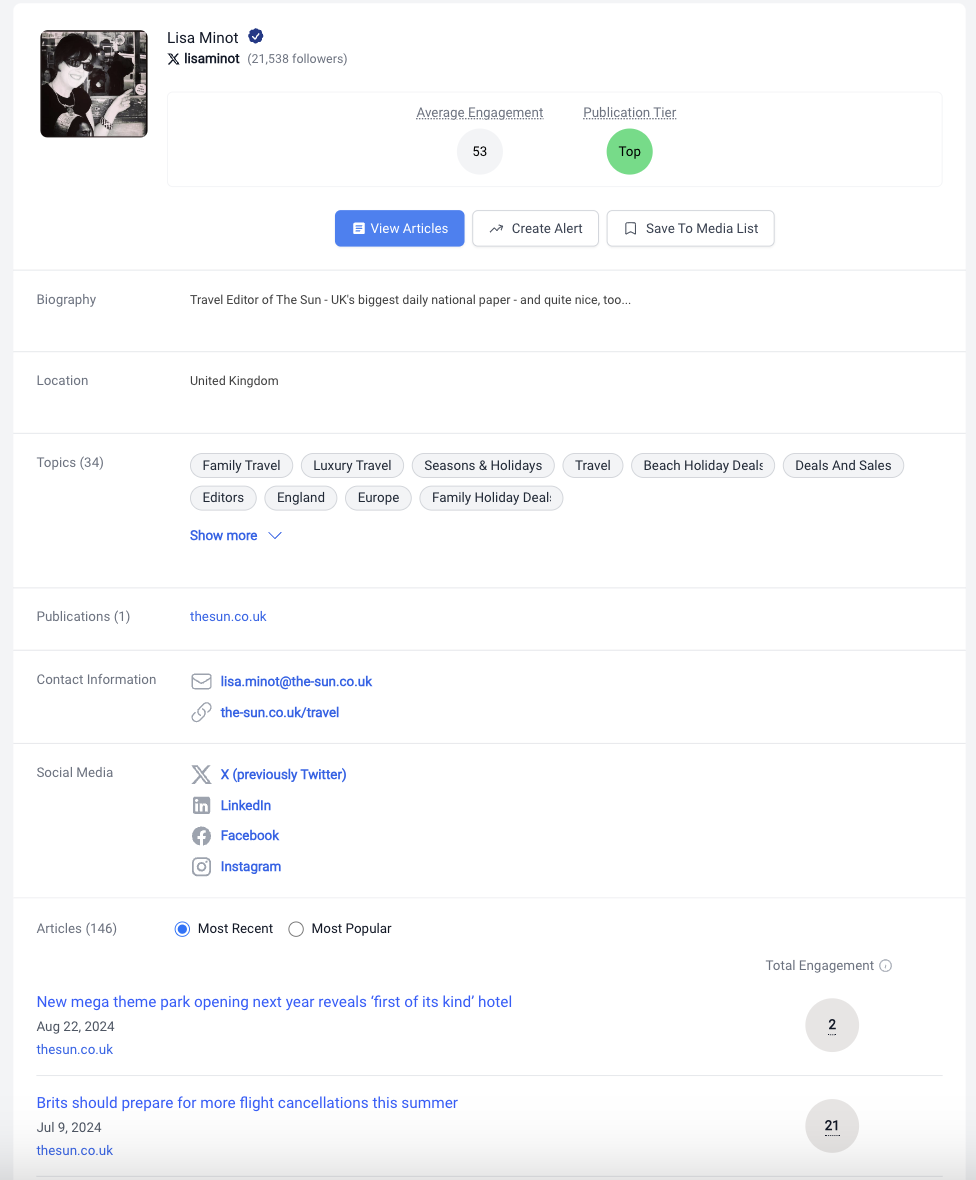
Since I’ve only used this tool for social monitoring and content ideation, I figured I’d consult some of the experts to learn what they said.
What Do the Experts Say?
I spoke with Alex Fiske, Senior Content Marketing Manager, at marketing agency, Aira about using BuzzSumo as a media database.
“The search engine provides plenty of filtering options, including something new that I haven’t seen before, ‘recent article count’ which gives a sense of how frequent of a writer the journalist is for the platform.
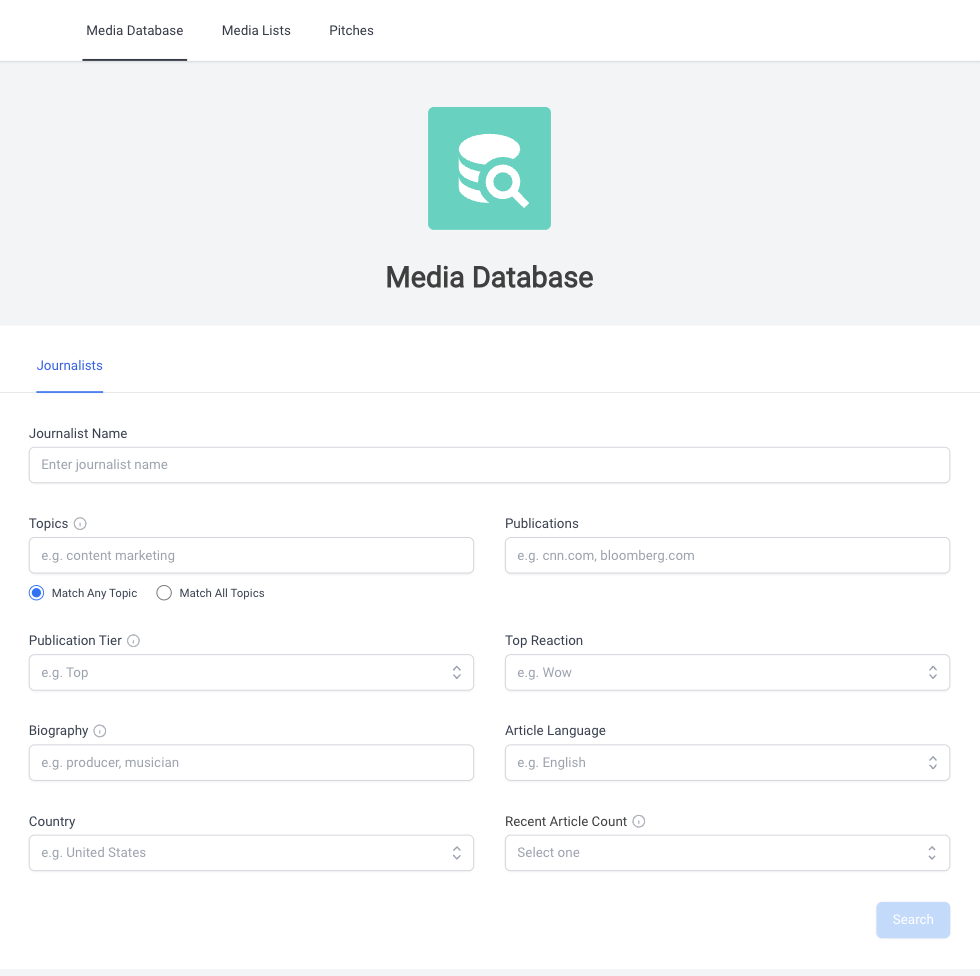
This can be really useful for prospecting lists as I’m able to filtre out those who have perhaps written one-off articles about the topic.”
Key Features
Alex wanted to call out the ‘Publication tier’ filter. We actually saw a similar feature in Meltwater, though it’s not as prominently featured as with BuzzSumo.
“This gives a quick glance and how ‘big’ the publication is the journalist writes for – especially handy when searching for more niche websites.”
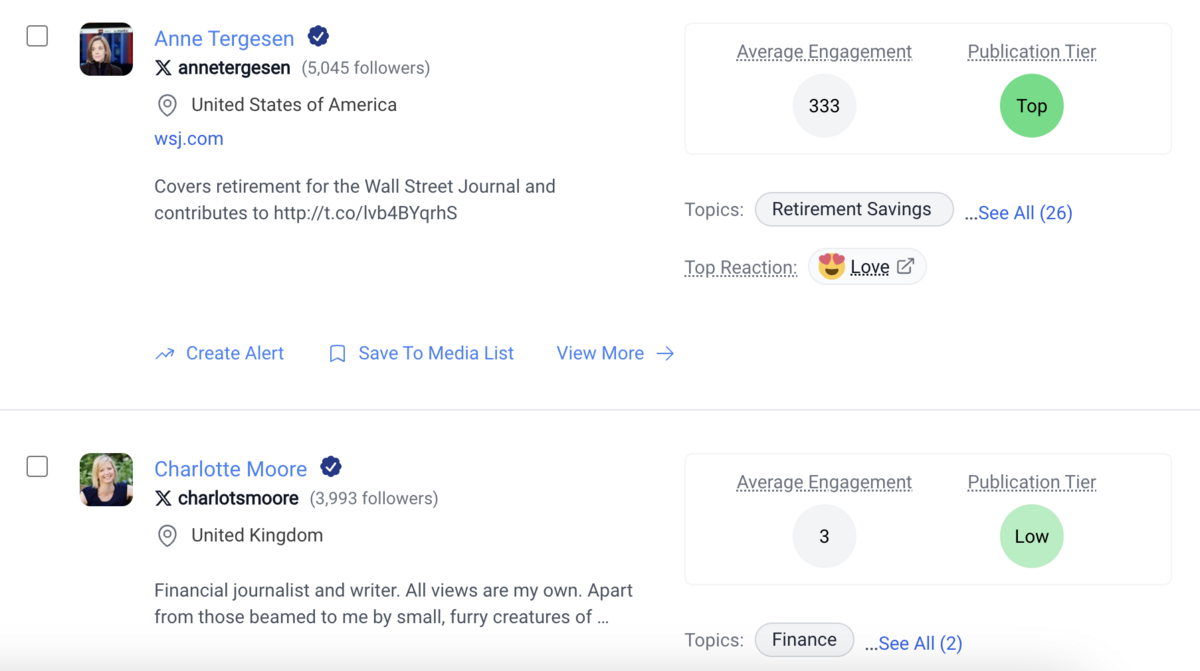
“I also like how you can set an alert for journalists when they publish news articles.”

“This is really handy for any reactive outreach as well as tracking for your own coverage!”
Pricing
To access the media database, you need the PR/Comms plan which costs $299/mo.
9. Meltwater – Best Media Monitoring

Meltwater is the other of the two significant legacy all-in-one PR software tools besides Cision and MuckRack.
They offer a media database and a supportive feature set that includes media monitoring, social listening, and PR analytics.
Meltwater’s site says the tool features 270,000 global news sources, social media platforms, forums, blogs, print publications, broadcasts, and podcasts.
According to many reports, Meltwater’s media monitoring is one of the best features (given that this is where Meltwater started). Still, many say that the quality of their media database leaves a bit to be desired.
Here is a peek at the search interface:
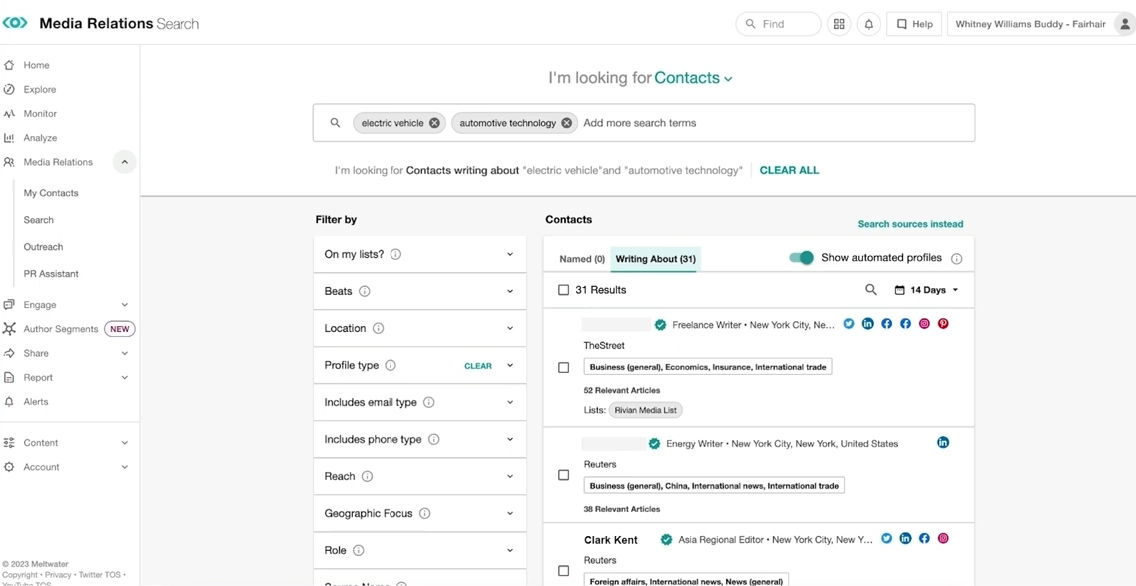
As you can see, it features many of the same search features as Cision.
What Do the Experts Say?
I reached out to some users about Meltwater from a media database perspective, and most felt that it was really a media monitoring tool first and a media database second, putting it behind Cision and Muck Rack.

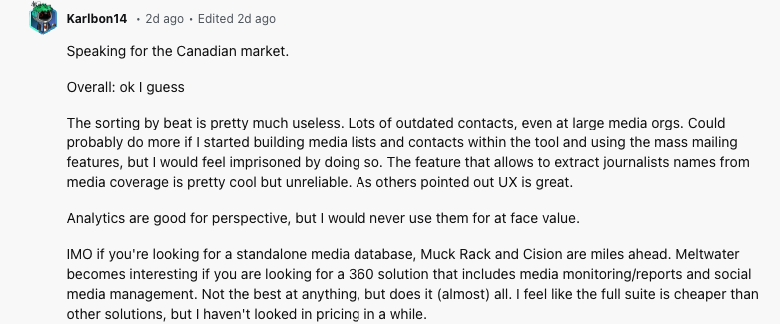
You can see that echoed in some reviews from sites like Trust Radius or Capterra.
Key Feature
I didn’t get many feature suggestions, so I decided to do some more digging on my own.
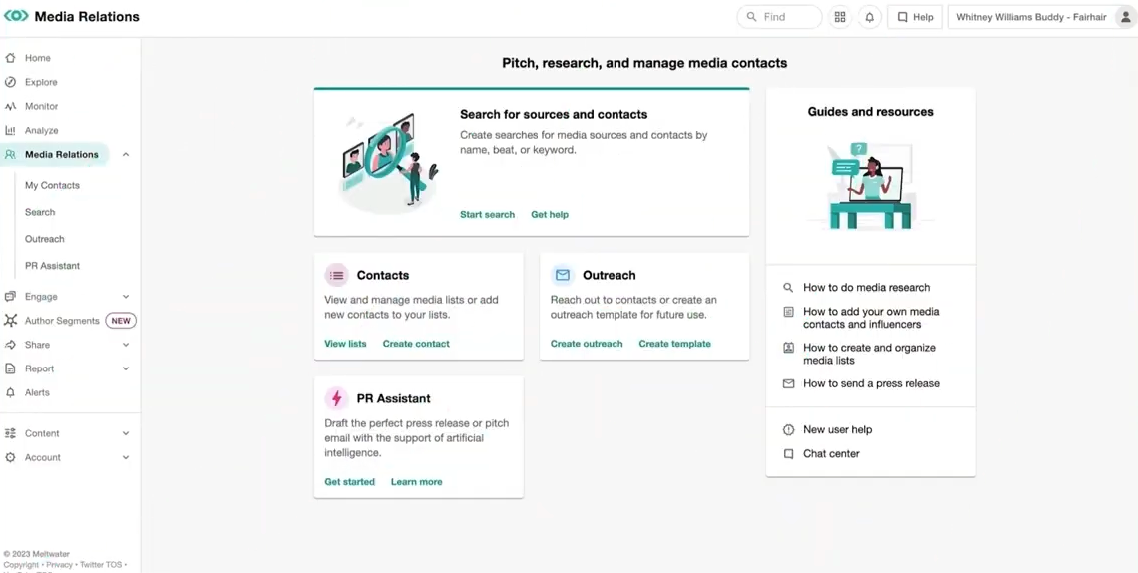
I appreciate media databases that get the type of outreach we do as PRs. Not every database breaks down the “reach” as clearly here as Meltwater.
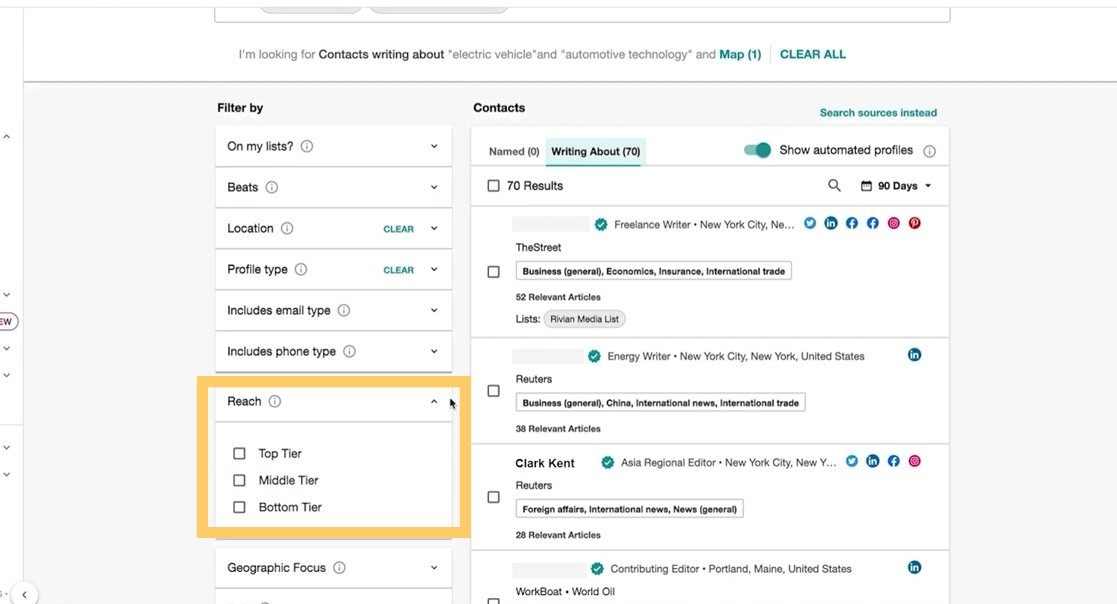
While this may not be a groundbreaking feature, I’m looking for things that will make you better and faster at your job.
So, to me, filter features like this stand out.
But, since the media monitoring is where Meltwater started, you can see how they’ve incorporated it into their workflow.
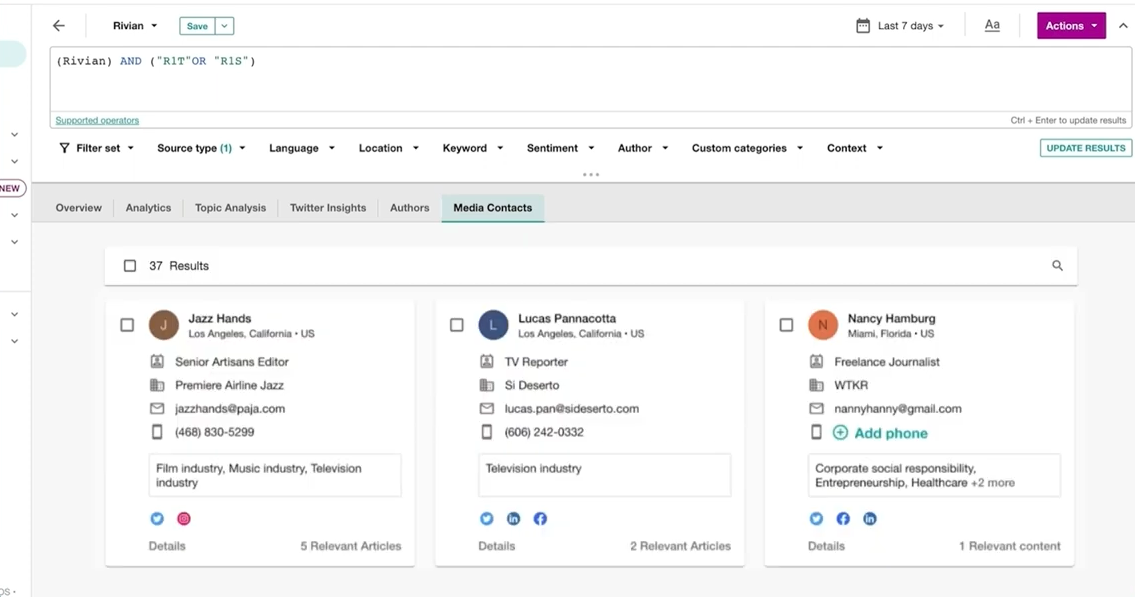
When searching for mentions of your brand, it will also show you the contact information of the journalists, which is incredibly helpful and a time saver.
Pricing
Meltwater does not advertise its costs, so you’ll need to contact for understand the full pricing breakdown.
Based on Prowly and Prezly’s research, we estimate around $7,000- $8,000/yr. (Note that both are competitors of Meltwater.)
10. Qwoted – Free

Qwoted is primarily a tool for connecting journalists with experts for quotes, similar to ResponseSource.
However, it has since branched out to offer a free media database. (The database was still in Beta at the time of publication.)
As you can see, it features fields like title, publication, and contact information.
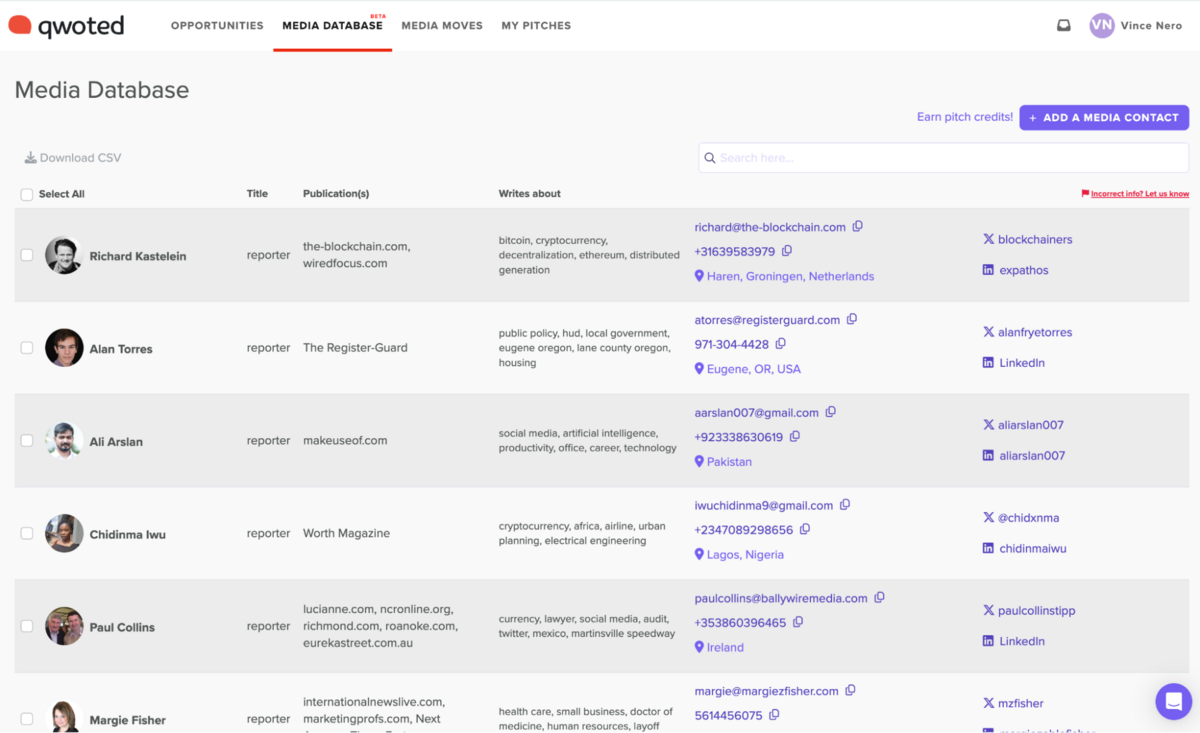
However, before jumping at the free tool, there are limitations. As expected, the database of a free tool is much smaller than a paid tool’s.
It also doesn’t provide helpful insights like Twitter/X posts or recent articles, for instance, and the search feature is limited to what you see in the screenshot.
Key Feature
The key “feature” here is that you can get free pitch credits if you add your vetted, confirmed media contacts.
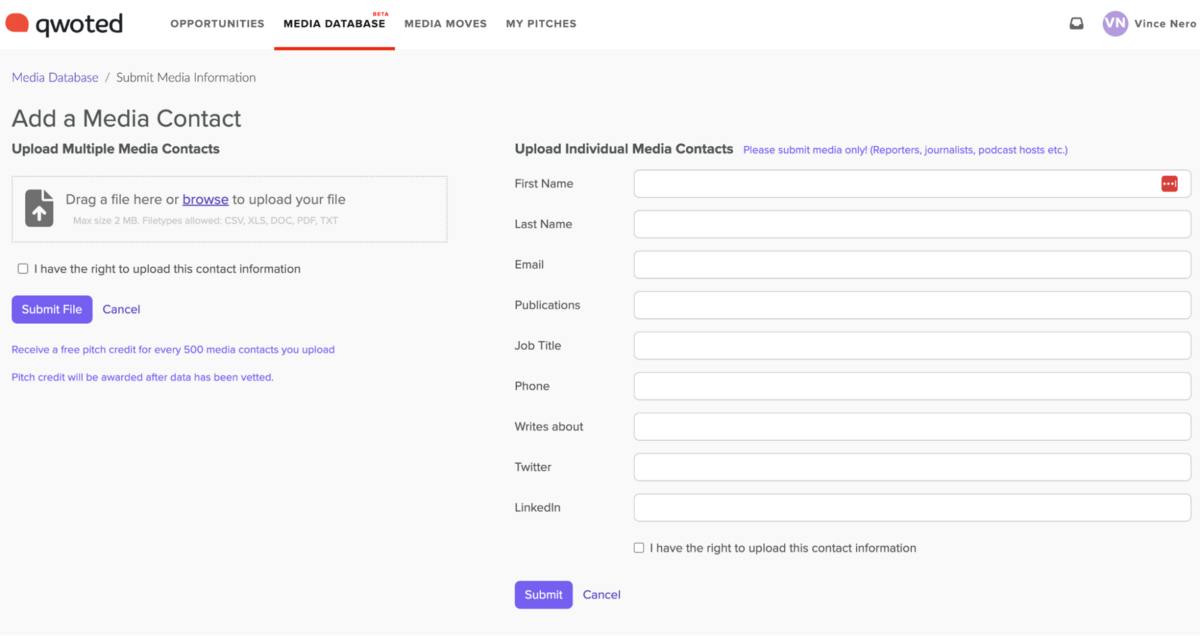
I was curious about what it meant to “have the right to upload this contact information,” so I reached out to their team (which is very friendly and quick to respond to).
Their (excellent and timely) customer service told me, “This is to ensure that any contact details that are uploaded are valid and legitimate and have not been obtained through illicit/unlawful means.”
So, any media lists you’ve gathered appear to be fair game.
What Do the Experts Say?
As a frequent user of Qwoted’s primary platform, this feature is a step in the right direction for the software, but not necessarily a replacement media database.
If you are doing any light outreach, it may help you find some contact information, like email addresses, but because it is basically user-updated, I’m not sure how accurate the contact information is.

That said, they do have a section called “Media Moves” that tracks the movements of journalists at different publications, which is something I haven’t seen from any other media database platform on this list.
Pricing
Qwoted is free.
Media Database Costs
It’s no surprise that media databases are expensive.
However, there are a few ways around the cost of a full media database.
Buying Seats from Someone Else (Not Recommended)
One loophole around costs that seems to come up often on Reddit is the buying and selling of seats.
One person will buy a multi-seat subscription to a tool and then “rent” or “sell” a seat to someone else.


I cannot begin to point out the inherent risks of something like this. There are client discretion issues and contract breaches, but the most obvious one is that all it takes is for the primary account owner to revoke access, and all of your client’s work goes down the drain.
But at this point, why not just create a list yourself?
Build Your Own Media List
I outlined an entire process for building your media list for free, and it’s fairly straightforward.
The process involves three main steps:
1. Identify Relevant Sites and Journalists
Use tools like Google News, Ahrefs, and SparkToro to find articles and websites that align with your campaign. Evaluate the sites based on topical relevance, authority, content quality, and the journalist’s focus.
We have an entire checklist for you on how to evaluate a site and a journalist for PR outreach.
2. Gather Contact Information
Use Google Search to find accurate email addresses for your contacts (or use ListIQ to do it in a fraction of the time).
3. Evaluate and Maintain the List
Before sending your campaigns, be sure to review and update your media list to ensure its effectiveness.
Then, when it comes time to send your outreach, use a platform like BuzzStream to send and track emails to build relationships with journalists over time.

 End-to-end outreach workflow
End-to-end outreach workflow



 Check out the BuzzStream Podcast
Check out the BuzzStream Podcast







